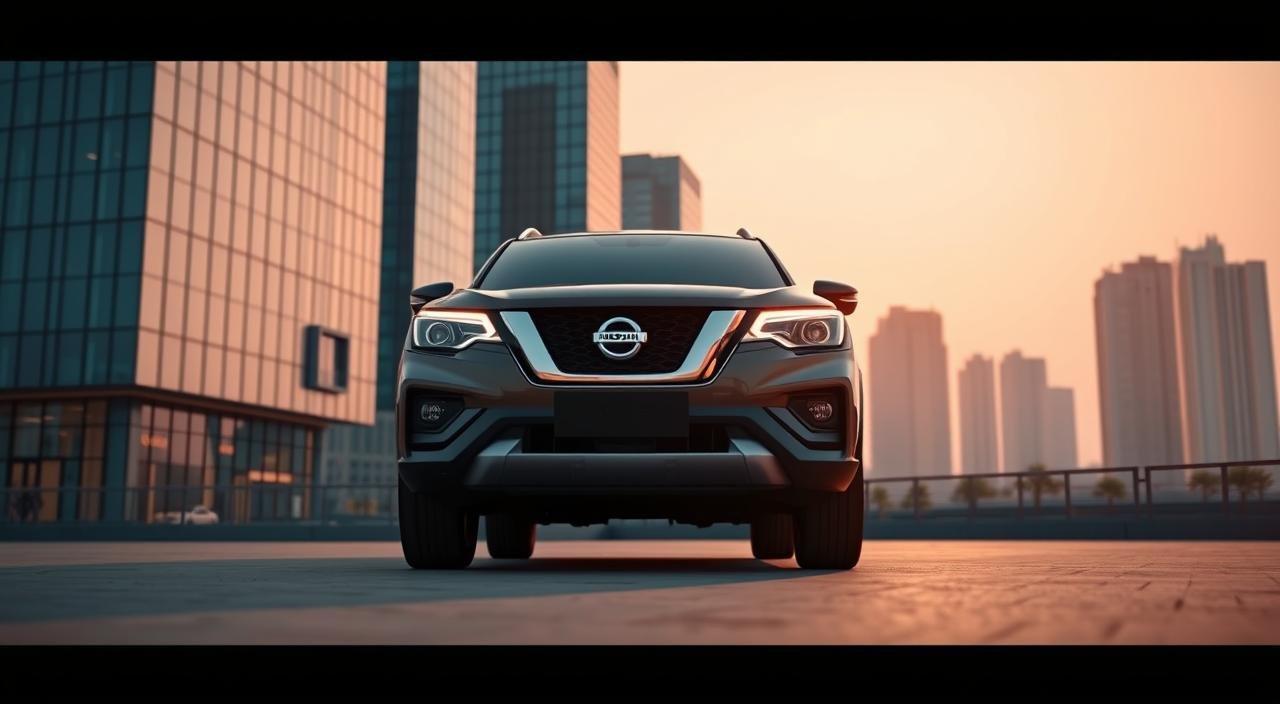
Oct
Nissan’s share in India’s car market has plummeted by 93% in ten years. Now, they have less than 0.5% of the market. This is a critical moment for Nissan in India.
The Tekton is more than just a new car. It’s a chance for Nissan to regain its footing in India’s competitive market. Set to launch in 2026, it draws inspiration from the Nissan Patrol, known for its ruggedness.
Nissan’s Chennai plant will make the Tekton for both Indian buyers and those abroad. The name, inspired by Greek words for craftsman, shows Nissan’s focus on quality. This car is part of Nissan’s plan to connect global markets while meeting local tastes.
Saurabh Vatsa, Nissan’s India head, sees the Tekton as key to their comeback. Nissan faces tough competition from Hyundai, Maruti Suzuki, and Tata Motors. The compact SUV market is where they can show they’re relevant to Indian buyers.
Key Takeaways
- The Tekton compact SUV launches in 2026 as Nissan’s flagship model for market recovery
- Manufacturing happens at Chennai facility for both domestic and export markets
- Design inspiration comes from the legendary Nissan Patrol SUV
- The vehicle represents Nissan’s second product under its One Car One World strategy
- Nissan currently holds less than 0.5% market share in India after years of decline
- The Tekton name means craftsman in Greek, reflecting engineering excellence
Overview of Nissan’s Current Situation in India
Nissan is at a key moment in India’s car market. It was once a hit with the Micra and Sunny. Now, it’s facing a drop in Nissan India market share and needs to boost its presence in this booming market.
Recent Challenges Faced by Nissan India
Nissan has faced tough times in India. Sales fell after it stopped making the Terrano and Kicks. The number of dealerships went from over 270 in 2018 to about 140 in 2023. Customers are upset because service centers can’t get parts.
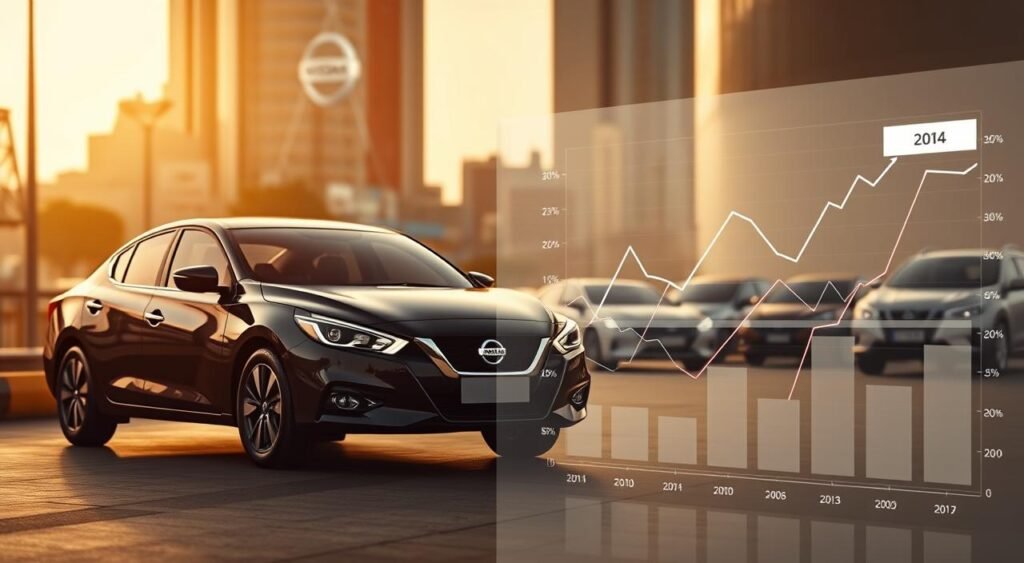
Market Position and Competition
Nissan now has less than 1% of India’s car market. The Magnite SUV is its main seller, with 3,000 units sold each month. Hyundai and Maruti Suzuki lead with over 60% of the market. The X-Trail SUV is pricey at ₹49.92 lakh but sells very few units.
Consumer Sentiment and Brand Perception
Indian car buyers have mixed views on Nissan. They like the Magnite but are worried about service. People are concerned about costs and resale value. The Tekton impact on Nissan could change things if Nissan fixes service issues and offers better support.
Introduction to the Nissan Tekton
Nissan has entered the SUV market with the Tekton. This vehicle aims to boost the brand’s image in the automotive industry in India. It combines bold looks with practical features for Indian buyers. The Tekton takes inspiration from Nissan’s Patrol but fits local tastes and prices.
Specifications and Features of the Tekton
The Tekton looks powerful, thanks to its Patrol-inspired design. Its front has a sculpted bonnet and unique C-shaped LED lights. The front bumper makes it stand out from other SUVs.
The side view shows a strong stance and clean lines. The Double-C door design nods to mountain ranges, like the Himalayas. The rear has a red light bar and C-shaped tail-lamps with the Tekton name on the tailgate. Alfonso Albaisa calls it imposing and stylish, aiming to set new standards in the automotive industry in India.
Target Audience for the Tekton
The Tekton is for urban families wanting a premium SUV without a high price. Young professionals and growing families are its main audience. This shows Nissan’s new approach to meet India’s growing middle class.
Comparison with Nissan’s Previous Models
The Tekton is built on the Renault Duster platform, like the Terrano. Its interior looks more premium than the Duster’s third generation. This shows Nissan’s effort to improve and gain more market share in India’s SUV market.
The Role of Electric Vehicles in Nissan’s Strategy
Electric vehicles are key to Nissan’s plan to turn things around in India. The company is changing its lineup to meet the demand for cleaner, more efficient cars. The Tekton might come with different powertrain options to attract various buyers.
Electrification Trends in India
India’s car market is quickly moving towards electric and hybrid vehicles. Sales of these cars jumped by 49% in 2023. People want cars that save fuel and cost less to run. Cities like Delhi, Mumbai, and Bangalore are leading this change.
The Tekton could lead the way with advanced powertrain options. This would put Nissan ahead of its competitors.
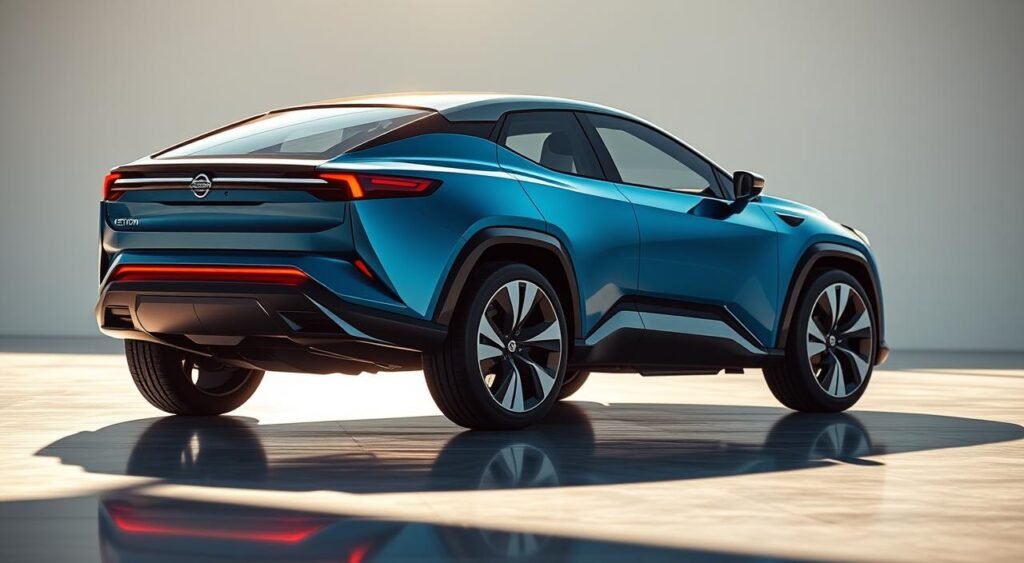
The Tekton as an Electric Vehicle
The Tekton might have a petrol engine or a hybrid system. A hybrid version would make Nissan competitive with Maruti Suzuki Grand Vitara and Toyota Urban Cruiser Hyryder. This approach could help Nissan attract both traditional and eco-friendly buyers.
Government Policies Supporting EV Adoption
The Indian government is making electric cars more appealing. The FAME II scheme offers up to ₹1.5 lakh in incentives for electric cars. State governments also offer benefits like waived registration fees and lower road taxes.
These policies are great for the Tekton’s success in the market. If Nissan introduces electric variants, it could really benefit.
Competitive Landscape in the Indian Automobile Market
The compact SUV segment is a hot spot for car makers in India. People want cars that are good for city driving and comfortable on highways. Tekton Nissan India is joining the fray, but it faces tough competition from established brands.
Key Competitors for Nissan India
Several big names lead the compact SUV market. The Hyundai Creta tops the list, selling over 15,000 units every month. The Kia Seltos is close behind, known for its premium features and style.
Maruti Suzuki Grand Vitara uses its wide service network to its advantage. Honda Elevate and Toyota Hyryder focus on reliability.
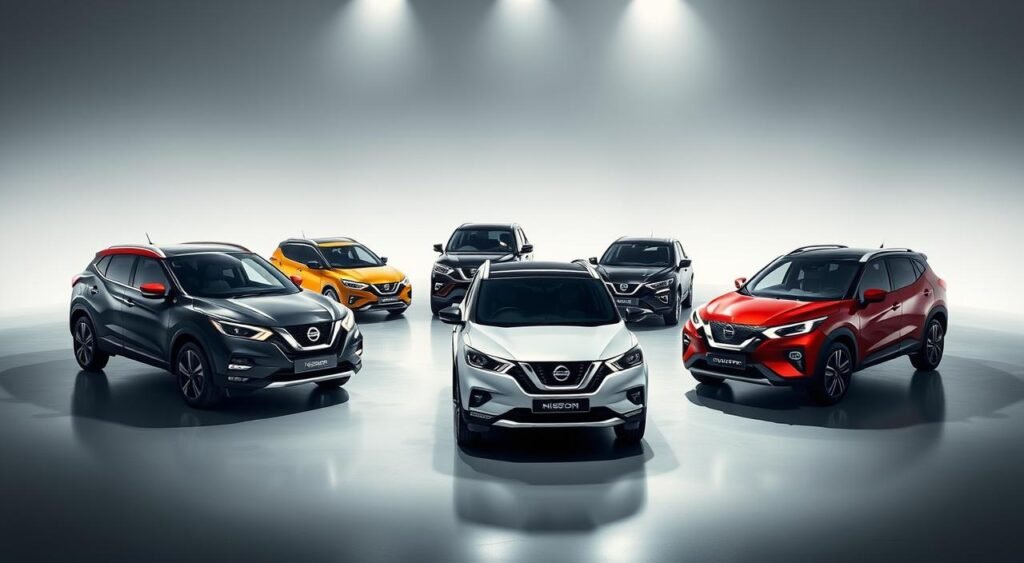
Strategies Employed by Rivals
Competitors use different strategies to attract buyers. Hyundai and Kia offer cars with lots of features like panoramic sunroofs and ventilated seats. Maruti Suzuki focuses on saving money on fuel and maintenance.
Toyota appeals to those who care about the environment with hybrid powertrains.
How the Tekton Stands Against Competitors
The Tekton Nissan India stands out with its true SUV design. It has a strong build and lots of room inside. It’s priced well, making it a good deal compared to others.
But, it doesn’t have a sunroof, which might hurt its sales. Sunroofs are very popular in India.
Marketing Strategies for the Tekton Launch
Nissan aims to make a big splash in India’s C-SUV market with the Tekton. They want to show off their rich history and meet the needs of ambitious buyers. These strategies focus on what Indian customers want, while keeping Nissan’s global image in mind.

Approaches to Reach Target Consumers
The Tekton’s marketing campaign leans on its Patrol legacy to attract buyers. Nissan is looking at creative professionals and young families. They highlight the car’s global standards, made for Indian roads.
Utilizing Digital Marketing Channels
Digital marketing is key for Nissan’s Tekton. They use:
- Social media campaigns on Instagram and YouTube to show off design
- Virtual showrooms for online exploration
- Targeted ads for urban 25-45 year olds
- Interactive configurators on Nissan India’s website
Collaborations and Partnerships
Strategic partnerships boost the Tekton’s appeal. Nissan teamed up with Renault for cost-effective production in Chennai. This partnership helps keep costs down while keeping quality high.
Nissan also plans to expand its dealer network. They aim to reach more buyers in tier-1 and tier-2 cities. This strategy targets both the domestic market and select export markets.
Customer Feedback and Expectations
Customer feedback is key to the success of new cars. For the Tekton to increase Nissan India market share, it must meet buyer expectations. People have clear ideas about what they want in a car, including features and price.
Insights from Potential Buyers
Indian buyers want top-notch interior features. They look for:
- 10.1-inch infotainment touchscreen with wireless Android Auto and Apple CarPlay
- 7-inch digital instrument cluster for a modern look
- Wireless charging for easy use
- Premium materials and finishes inside
They also like personalizing their cars. The Tekton bonnet lettering is a hit as a way to make the car unique.
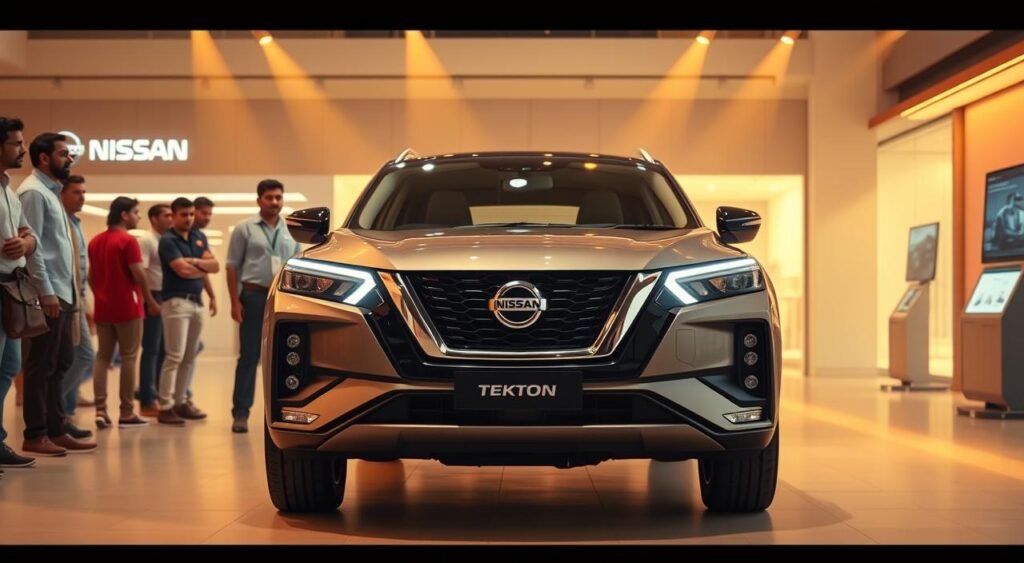
Importance of Customer Reviews
Online reviews and word of mouth are big in India’s car market. What early buyers say about the Tekton will shape opinions. Good feedback on quality, features, and value can help it gain acceptance.
Addressing Common Concerns
Buyers worry about how the Tekton compares to Hyundai Creta and Kia Seltos. It must be seen as a premium car to match its price. Also, making sure there are enough service centers and affordable spare parts is key to growing Nissan India market share.
Dealership Network and Availability
Nissan India aims to strengthen its dealership network across the country. The launch of Tekton in 2026 will need a wider reach to serve tier-2 and tier-3 cities. Chennai will continue to be the main hub for both domestic sales and exports.
Expansion Plans for Nissan in India
Nissan plans to grow its dealership count from 270 to 350 by 2026. The auto industry in India is booming, with smaller cities becoming key markets. New showrooms will open in states like Uttar Pradesh, Gujarat, and Karnataka.
The company is focusing on areas with a growing middle class. These people are looking to buy modern vehicles.
Importance of Service and Maintenance
Service quality is key to keeping customers loyal in India’s competitive auto market. Nissan is addressing service center shortages by opening 100 new workshops. Each will have certified technicians trained in Chennai.
Regular maintenance packages start at ₹15,000 a year for basic coverage.
Strategies to Improve Customer Experience
Digital booking systems let customers schedule service appointments via mobile apps. Pick-up and drop services are available within 15 kilometers of dealerships. Nissan’s turnaround includes 24/7 roadside assistance and extended warranties.
| Service Feature | Current Status | 2026 Target |
|---|---|---|
| Dealership Count | 270 | 350 |
| Service Centers | 180 | 280 |
| Mobile Service Vans | 25 | 75 |
| Customer Response Time | 48 hours | 24 hours |
Financial Implications for Nissan India
The launch of Tekton Nissan India is a big deal for the company. The price of the new model will decide if it can increase Nissan India market share. This is important for Nissan to get back on track in a tough market.
Expected Costs and Benefits of Tekton Launch
The Magnite showed that Nissan can sell well in India with the right price. The Tekton needs to be affordable but also have top features. Making it in Chennai with Renault-Nissan Alliance cuts costs by 15-20%.
Impact on Sales and Revenue Targets
Tekton Nissan India aims to sell 3,000-4,000 units a month to hit revenue targets. This goal is reachable, thanks to the X-Trail’s lesson on pricing. The Tekton could double Nissan India market share to 2.5% in two years.
Long-term Financial Outlook
Setting the Tekton’s price between ₹8-12 lakhs makes it a strong competitor. This price helps Nissan keep profits high while drawing in more buyers. Working with Renault also cuts costs by 30%, making the investment pay off in under three years.
Environmental Impact and Sustainability
The car industry is under pressure to cut its environmental harm. Nissan’s Tekton shows the company’s dedication to green driving. It’s not just about selling cars; it’s about being responsible in India.
Tekton’s Environmental Credentials
The Tekton might have a hybrid engine, which cuts down on emissions. This makes it a leader in car innovation. It’s all about being fuel-efficient and powerful. The Tekton has:
- Less carbon emissions with hybrid tech
- High fuel economy, aiming for 25+ km/l
- Light materials to make the car lighter
- Systems that capture energy through braking
Nissan’s Commitment to Sustainability
Building the Tekton in Chennai shows Nissan’s local focus. It cuts down on emissions and supports the local economy. The factory also uses water recycling and solar power.
Consumer Awareness and Eco-Friendly Practices
Indian buyers are now more aware of the environment. The Tekton’s green features attract them. Nissan teaches people about the benefits of eco-friendly cars, like saving money and being kind to the planet.
Conclusion: Can the Tekton New Success for Nissan India?
The Tekton is a big moment for Nissan India. It enters a market full of rivals like Hyundai Creta and Kia Seltos. Nissan must offer good prices, a strong network, and reliable service to stand out.
A hybrid powertrain could make the Tekton special. This could help it beat other cars.
Summary of Key Points
Nissan India’s future depends on many things. The Tekton has bold design and luxury inside to draw in buyers. Saurabh Vatsa thinks it will help Nissan grow in India.
The SUV has a strong look and wants to challenge the top cars. Alfonso Albaisa says it shows Nissan’s best SUV qualities. Success needs good pricing, positioning, and service.
Final Thoughts on Nissan’s Future
Nissan has a tough fight in India’s car market. It needs to win back trust and beat strong rivals. The Tekton aims to be premium and different with its design.
Nissan wants to give what today’s buyers want without high prices. Success will show in how well Nissan does at every step.
The Road Ahead for the Tekton
The Tekton’s journey in India will test Nissan’s dedication. Early feedback and sales will show if Nissan can turn things around. The SUV must stand out against other cars and find its own place.
Nissan’s growth depends on more dealers and better service. The Tekton is a chance for Nissan to shine in India again.
FAQ
What is the Nissan Tekton and when will it launch in India?
The Nissan Tekton is a compact SUV coming in 2026. It’s part of Nissan’s plan to come back strong in India. This SUV is inspired by the legendary Nissan Patrol and is the second car under Nissan’s One Car One World plan. It will be made in Chennai for both Indian buyers and some exports.
How does the Tekton fit into Nissan’s turnaround strategy for the Indian market?
The Tekton is key to Nissan India’s comeback, says Managing Director Saurabh Vatsa. After losing ground by stopping popular models like the Micra and Terrano, Nissan sees the Tekton as a game-changer. The plan includes more dealerships, better service, and good prices to win back customers.
What are the key design features and specifications of the Tekton?
The Tekton has a bold design inspired by the Patrol. It has a sculpted bonnet, C-shaped LED lights, and a strong front bumper. Its side looks upright with Double-C door accents, and the back has a red light bar and C-shaped tail-lamps.
It will have a big 10.1-inch screen for infotainment, a 7-inch digital display, and wireless charging.
Which competitors will the Tekton face in the Indian automotive industry?
The Tekton will compete in the compact SUV market. It will go up against the Hyundai Creta, Kia Seltos, and others. Its design is more like a traditional SUV, which might appeal to some buyers.
Will the Tekton offer hybrid or electric powertrain options?
Details on the Tekton’s engine are not out yet. But, it might have a petrol engine or a hybrid option. This could make it more appealing to buyers who want efficient cars and care about the environment.
What is Nissan’s current market share and position in India?
Nissan India’s market share is small. The Magnite is doing okay, but the X-Trail is too pricey. Nissan needs to improve its service network to win back customers and boost its reputation.
How will pricing impact the Tekton’s success in India?
Pricing is very important for the Tekton’s success. The Magnite shows that being affordable can help. But, the X-Trail’s high price didn’t work. Nissan needs to find the right price to compete well.
What role does the Renault partnership play in the Tekton’s development?
Nissan’s partnership with Renault helps in making the Tekton. It uses the Renault Duster platform, like the Terrano. This partnership lets Nissan make a premium car without spending too much.
What are the main challenges facing the Tekton launch?
The Tekton faces tough competition and might not have all the features buyers want. It lacks a sunroof, which is popular. Nissan needs to work on its service, pricing, and marketing to succeed.
How does Tekton leadership in the automotive sector view the vehicle’s ?
Alfonso Albaisa sees the Tekton as bold, stylish, and a new standard. Saurabh Vatsa believes it will lead Nissan’s growth in India. It has a strong look, premium interior, and aims to disrupt the market.
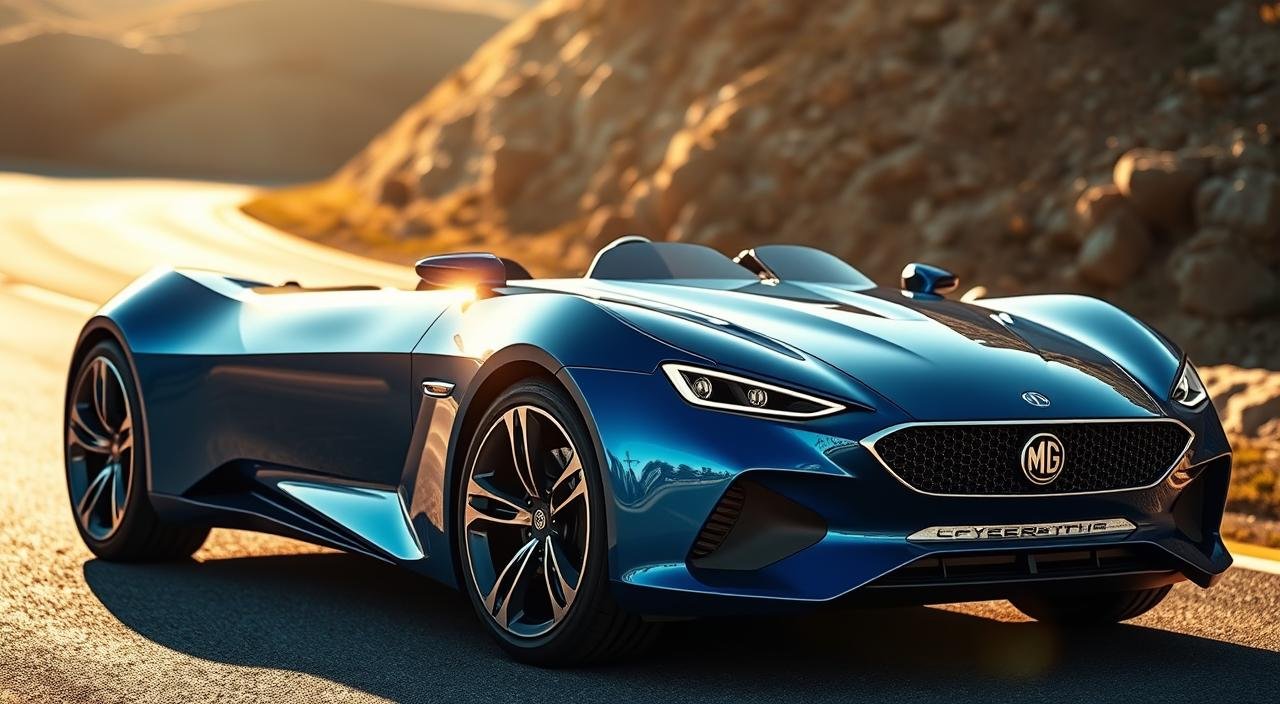
Aug
Can an electric vehicle roadster from MG challenge the design supremacy of traditional sports cars on Indian roads? The MG Cyberster Design is a big change for MG, known mainly for SUVs like the Hector. This electric roadster breaks new ground with its bold styling and futuristic look.
The Cyberster has scissor doors that open with just a button. Its low, wide stance makes it stand out and grab attention. Its roadster design is different from the usual designs in India’s electric car market.
This bold electric roadster shows what happens when car makers take risks with design. The MG Cyberster Design mixes eye-catching looks with smart engineering. It’s a car that looks as advanced as it is electric.
Key Takeaways
- MG Cyberster represents a dramatic departure from the brand’s traditional SUV focus
- Functional scissor doors open with a simple button push for theatrical entry
- Low, wide stance creates commanding road presence on Indian streets
- Sweeping roadster profile challenges conservative EV aesthetics in the market
- Design combines striking visual elements with practical engineering solutions
- Every curve serves both aesthetic appeal and functional purpose
Introduction to MG Cyberster Design
The MG Cyberster is a big step for MG in the electric car world. It’s a roadster that looks amazing and works well. Its design shows MG’s goal to change what electric sports cars can be today.
Overview of the MG Cyberster
The Cyberster has scissor doors that open up, not out. These doors have sensors to avoid hitting things. It’s a two-seater with a low profile and wide stance, just like a classic roadster.
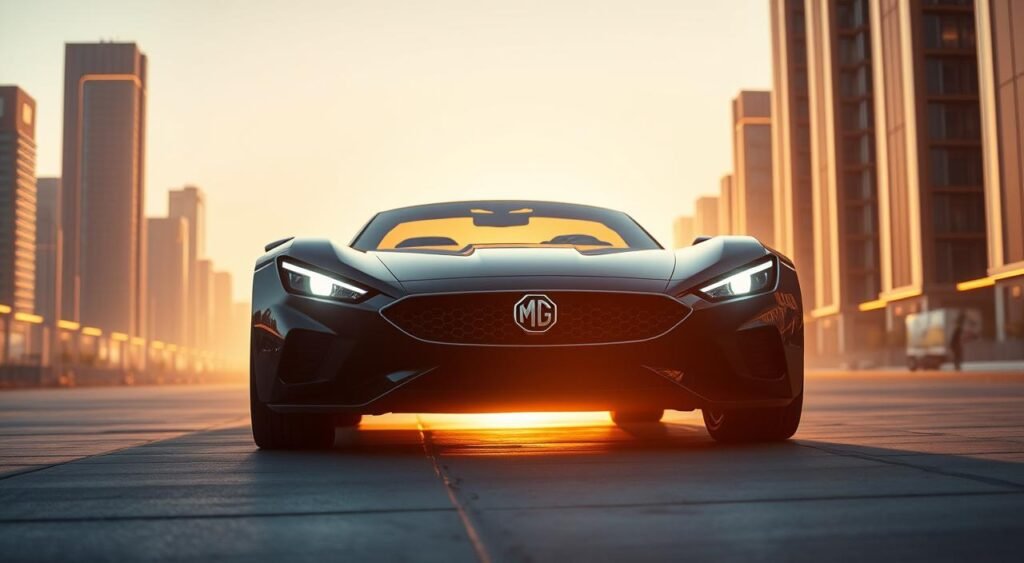
| Dimension | Measurement | Design Impact |
|---|---|---|
| Length | 4,535 mm | Compact for agility |
| Width | 1,913 mm | Wide track for stability |
| Height | 1,329 mm | Low center of gravity |
| Wheelbase | 2,690 mm | Extended for smooth ride |
Significance of Design in Electric Vehicles
Electric cars need new designs because they don’t have engines. The Cyberster’s design cuts through air and looks cool. It shows how EVs can be both beautiful and efficient.
Bold Front-End Aesthetics
The MG Cyberster stands out as a trendsetter in the automotive world. Its striking front-end design grabs attention. It perfectly blends elegance with performance, setting new standards for EV looks.
Signature Headlights and Grille Design
The Cyberster’s LED headlamps make a bold statement. They are nestled in unique petal-shaped daytime running lights. The wide grille and sharp bonnet lines add to the car’s bold look.
This design keeps things simple yet stylish. It shows off the sleek look that modern electric cars are known for.
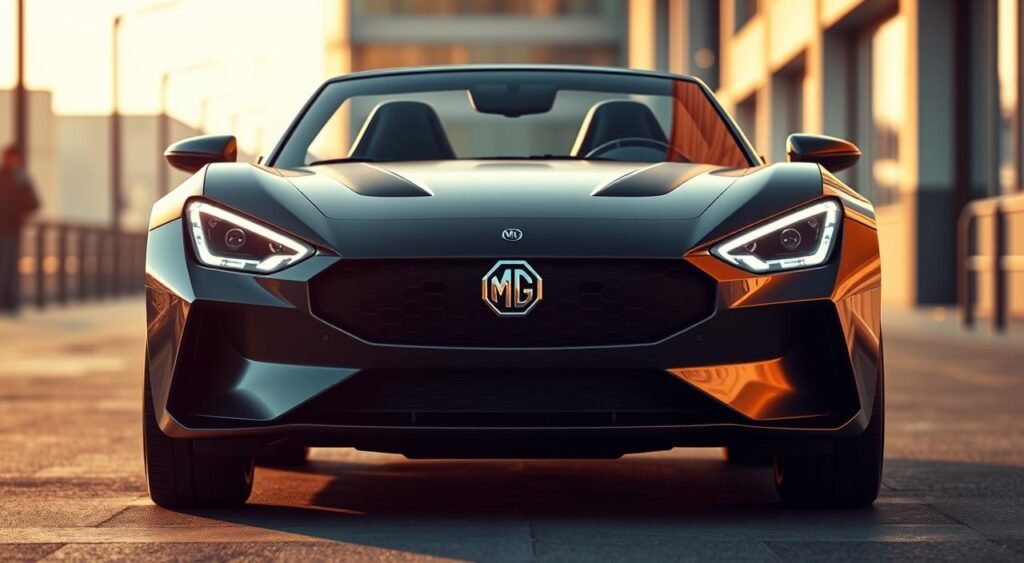
Aerodynamic Lines and Sculpted Bodywork
Every part of the Cyberster is designed with purpose. The long bonnet meets a short rear deck, giving it classic roadster looks. This car is a trendsetter because of its:
- Clean sculpting that maintains balanced proportions
- Smooth transitions between body panels
- Wind-optimized surfaces for improved efficiency
- A low-slung profile that enhances the sporty character
The bodywork is a blend of beauty and function. It guides air smoothly and keeps the Cyberster looking sleek. This design makes the MG Cyberster a leader in electric roadster styling.
Modern Interior Features
The MG Cyberster’s interior is a mix of the latest tech and top-notch craftsmanship. Every part shows a focus on quality, from solid doors to perfectly aligned panels. The interior design is as stunning as the outside, making every drive special.
Dashboard Design and Technology Integration
The dashboard is designed for the driver, with clear digital displays. A curved cluster shows important info, and the central screen handles entertainment and settings. It also has voice controls and connects to smartphones, making it easy to use.
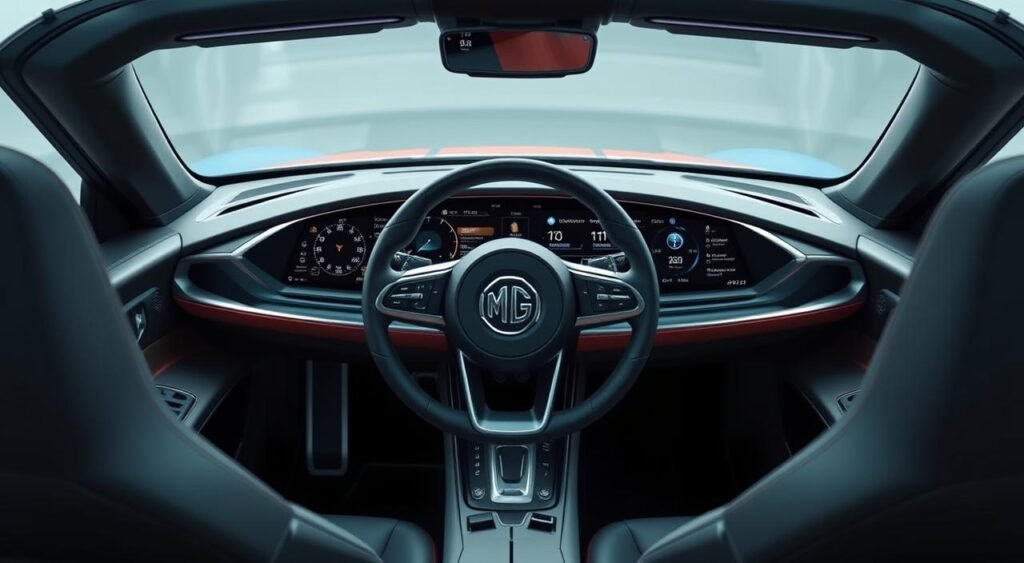
- Triple-screen setup with customizable displays
- Wireless Apple CarPlay and Android Auto
- Ambient lighting with multiple color options
- Digital climate control system
Material Choices for a Premium Feel
MG picked materials that are both luxurious and strong. The dashboard and doors have soft-touch surfaces, while metal adds a nice look. The seats are covered in quality leather with contrasting stitching that matches the car’s color.
| Interior Component | Material Used | Premium Feature |
|---|---|---|
| Dashboard | Soft-touch polymer | Anti-glare coating |
| Seats | Nappa leather | Heated and ventilated |
| Steering wheel | Perforated leather | Paddle shifters |
| Door panels | Alcantara inserts | Illuminated trim |
The cabin’s quality is top-notch, with precise panel gaps and smooth components. This tech integration makes the interior feel both modern and welcoming for daily use.
Color Palette and Customization Options
The MG Cyberster Design offers bold color choices. These options make the roadster stand out. Each color is picked to match the car’s sleek lines and modern look.
Available Colors and Their Impact
The MG Cyberster has two standout colors:
- Flare Red – A bright, eye-catching shade that highlights the car’s sporty vibe
- Nuclear Yellow – A bold color that matches the EV style of this modern sports car
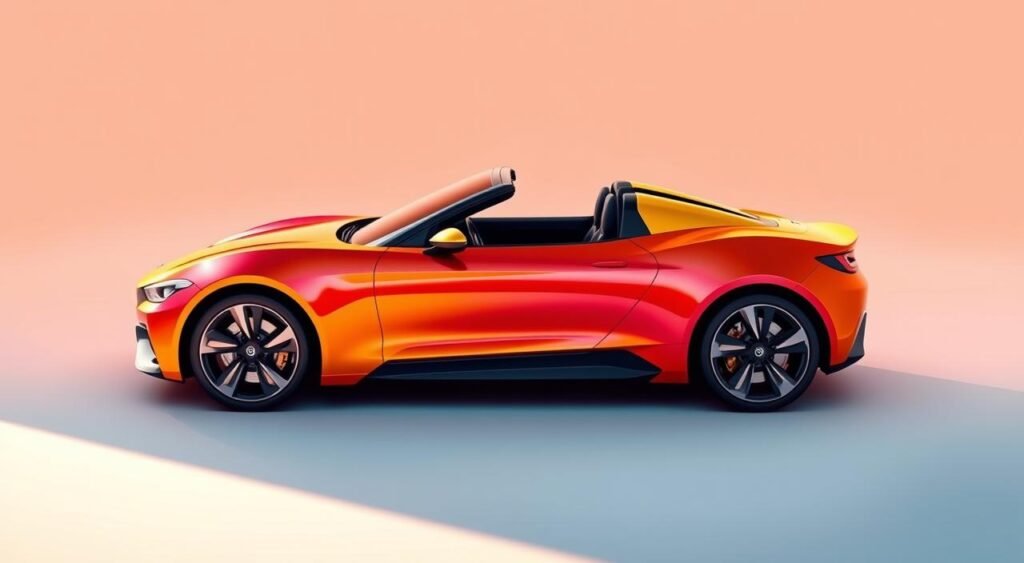
There are also more subtle colors. These might appeal to those who prefer a quieter look. But, they might not show off the MG Cyberster’s design as much.
Personalization Features for Owners
Customization goes beyond just colors. Owners can choose from different trim packages and accents. This lets them make a car that shows off their style while keeping the Cyberster’s EV look.
The mix of bold colors and subtle accents lets each owner make their unique roadster.
Innovative Lighting Technology
The MG Cyberster changes nighttime driving with its advanced lighting system. It shows how lights can look good and work well, setting new standards for EVs.
LED Lighting and Its Benefits
The Cyberster’s LED light bar makes a bold statement at the back. It makes the car look wider and lights it up better. The arrow-shaped tail lamps add a unique touch, like concept cars.
- They use less energy, saving on range.
- They last longer than old bulbs.
- They light up fast, without waiting.
- They shine light exactly where it’s needed, for safety.
Daytime Running Lights and Signature Design
The Cyberster’s petal-shaped DRLs are a design leap. They make the car’s front look unique and bright. This shape is clear in the day and makes the car stand out.
MG shows it can make EVs that are both safe and stylish. The lights fit perfectly with the car’s design, showing safety doesn’t have to mean sacrificing looks.
Performance-Driven Design Elements
The MG Cyberster is a true trendsetter in the automotive world. It perfectly combines style with performance. The soft-top fabric roof is a great example of this, opening in just 10 seconds. It keeps the car’s look sleek when closed.
Drivers can open the roof at speeds up to 50 kmph. This makes it easy to change the weather without stopping.
Weight Distribution and Handling
The Cyberster’s design focuses on balance. The battery pack is placed low in the car. This makes the car’s center of gravity as good as traditional sports cars.
The 20-inch alloy wheels are a big part of the car’s look. They also help the car grip the road well. This makes the Cyberster handle like a dream.
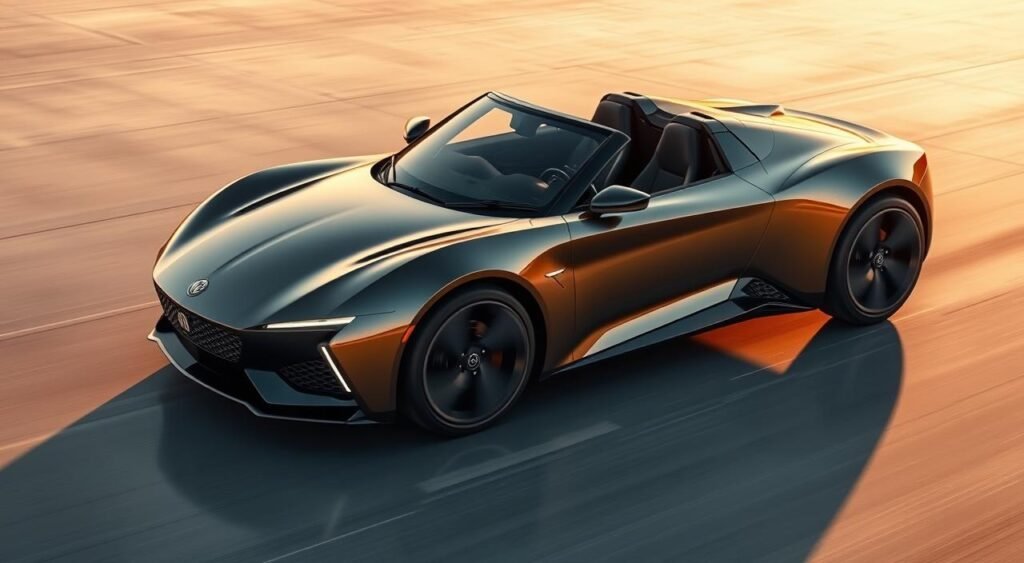
Impact of Design on Efficiency
The Cyberster’s design is key to its long range. Its body is shaped to cut through the air with ease. Every curve and crease has an aerodynamic purpose.
The front splitter and rear diffuser help a lot. The car’s doors and mirrors are designed to reduce wind resistance. The active grille shutters also help by adjusting airflow. These features help the Cyberster go further without losing its cool looks.
Conclusion: The Allure of the MG Cyberster
The MG Cyberster is a big leap in electric roadster design. It mixes classic sports car looks with the latest in electric tech. Its sleek design grabs attention from all sides, thanks to modern tech that boosts both performance and ease of use.
This car stands out in a world filled with sedans and SUVs. It brings a fresh, exciting vibe to the road.
Recap of Key Design Elements
The Cyberster shows MG’s big plans for electric cars. Its scissor doors add a cool touch, making getting in and out a show. The soft-top roof lets you drive with the wind in your hair, keeping the car’s sleek look.
Its lines and shapes flow smoothly, making it a feast for the eyes. The LED lights add to its look, shining bright at night in cities like Mumbai or Delhi.
The Future of Roadster Design in EVs
The Cyberster hints at a bright future for electric roadsters in India. It shows EVs can be thrilling and emotional, not just about saving fuel. As batteries get better and charging spots grow, more cars like this will hit the roads.
The Cyberster’s mix of new tech and stunning design sets a new standard. It proves electric cars can be just as fun to drive as their gas-guzzling cousins.
FAQ
What are the most distinctive design features of the MG Cyberster?
The MG Cyberster has scissor doors that open with a button press. It also has narrow LED headlamps and a full-width LED light bar at the back. The car has a classic roadster look with a low stance and wide wheels.
How does the MG Cyberster’s exterior design compare to traditional EV aesthetics?
Unlike many EVs, the Cyberster has bold styling. It has dramatic scissor doors and a sweeping profile. Its long bonnet, short rear deck, and 20-inch alloys give it a bold stance.
What color options are available for the MG Cyberster?
The Cyberster comes in Flare Red and Nuclear Yellow for a bold look. But, it also has more subtle colors for those who prefer less flash.
How practical are the scissor doors for everyday use?
The Cyberster’s scissor doors are practical for daily driving. They have sensors to avoid hitting objects and close with a solid sound. This shows the car’s premium quality.
What cutting-edge technology is integrated into the Cyberster’s lighting system?
The Cyberster has LED headlamps with unique DRLs. Its rear light bar and arrow-shaped tail lamps give it a futuristic look.
How does the retractable soft-top affect the vehicle’s design and functionality?
The soft-top operates quietly and can be changed at speeds up to 50 kmph. It retracts neatly, keeping the car’s lines clean.
Is the MG Cyberster positioned as an automotive trendsetter in India’s EV market?
Yes, the Cyberster is MG’s bold move into the EV market. It combines futuristic design with innovation, making it a leader in India’s EV scene.
How does the interior design complement the bold exterior aesthetics?
The interior focuses on tech and premium materials. It has well-designed panels and solid doors. This creates a space that matches the car’s striking look.
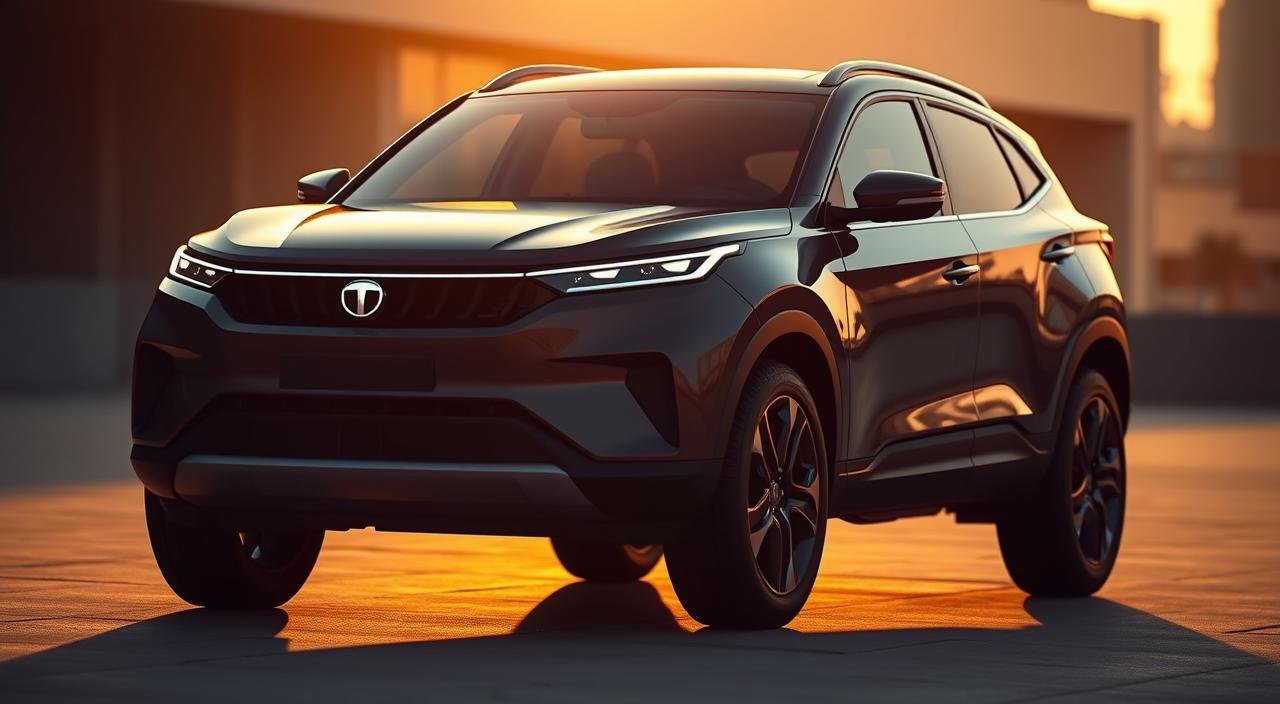
Jun
Are you wondering what sets the Tata Harrier EV apart from the regular Harrier? The buzz around the new Mahindra Bolero 2025 is huge, but Tata’s electric SUV is also getting attention. The EV version has cool features that the regular Harrier doesn’t. It’s packed with advanced tech and better performance. Is the electric Harrier the top SUV for today’s drivers?
The Tata Harrier EV brings the SUV to a new level with its features. It has a bigger infotainment system for staying connected and fun. The boss mode lets you control it from the back seat. You also get a digital IRVM for a clear view behind and a 540-degree camera for full visibility.
With summon mode, your Harrier EV can come to you! Auto park assist makes parking easy. Plus, it has special EV features like V2V and V2L for more uses.
Key Takeaways
- Tata Harrier EV offers unique features compared to the regular Harrier
- Advanced tech includes a larger infotainment system, boss mode, and digital IRVM
- 540-degree camera and auto park assist enhance visibility and convenience
- Summon mode allows the Harrier EV to come to you
- EV-specific functions like V2V and V2L provide added versatility
Introduction to Tata Harrier Models
The Tata Harrier is a hit in India, loved for its sleek design, comfy interior, and strong performance. With the upcoming Mahindra Bolero model in 2025, Tata Motors is adding diesel and electric Harriers. This meets the needs of many customers.
Overview of Tata Harrier
Launched in 2019, the Tata Harrier is built on the OMEGA Arc platform, inspired by Land Rover’s D8. It has a roomy cabin, top-notch features, and a smooth ride. The Harrier’s main specs are:
| Specification | Details |
|---|---|
| Engine | 2.0L Kryotec Diesel |
| Power | 168 bhp @ 3750 rpm |
| Torque | 350 Nm @ 1750-2500 rpm |
| Transmission | 6-speed Manual / Automatic |
| Seating Capacity | 5 Passengers |
Brief Introduction to Tata Harrier EV
The Tata Harrier EV is coming in 2024, as the electric version of the SUV. It will have a big battery and the latest electric tech. This makes it a green choice for those who care about the planet.
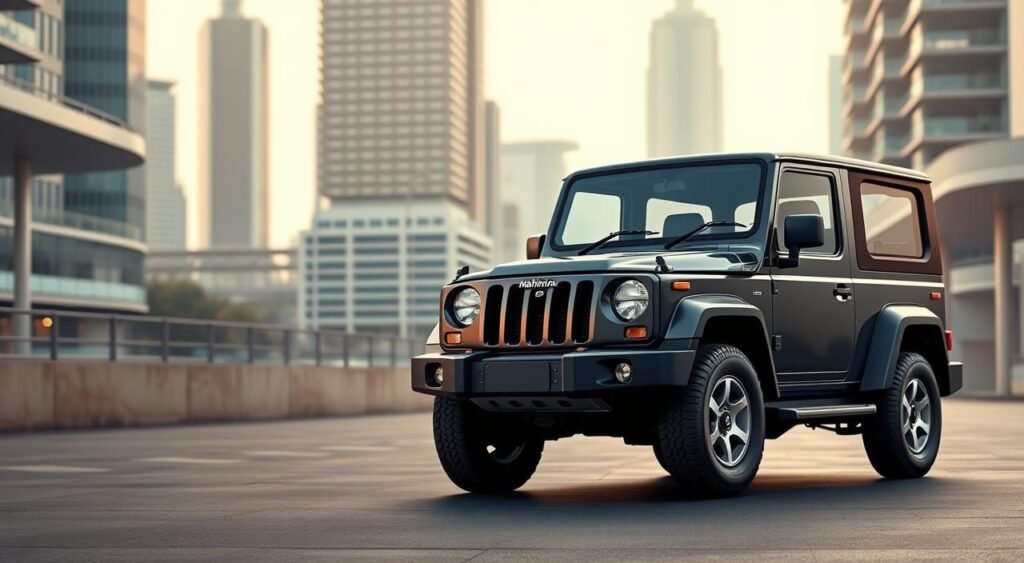
Importance of EV Technology
Electric cars are becoming more popular because they’re good for the environment and save money. The Tata Harrier EV shows how important EVs are getting in the car world. As more people choose electric, car makers like Tata are working hard to make better EVs. This helps us move towards a cleaner, greener future.
Performance Comparison: EV vs Regular
The Tata Harrier EV and the regular Harrier offer different driving experiences. The electric version has instant torque and quick acceleration. This makes it exciting for those who love a thrilling drive.

Acceleration and Torque Differences
The Harrier EV accelerates from 0 to 100 km/h in just 7 seconds. Its electric motor provides instant torque for a smooth, powerful start. In contrast, the regular Harrier, with a 2.0-liter diesel engine, takes about 10 seconds to reach the same speed.
Driving Range of the Harrier EV
The driving range is a key factor for electric vehicles. The Tata Harrier EV has two battery options. The base model offers up to 350 km on a single charge. The higher-end model has a range of 627 km, certified by MIDC.
Fuel Efficiency of Regular Harrier
The regular Harrier is fuel-efficient, despite not being electric. Its 2.0-liter diesel engine gets around 16 km/l in the city and up to 20 km/l on highways. This makes it a cost-effective choice for those who prefer traditional engines.
As Mahindra Bolero prototype spotted testing shows, car makers are working on both electric and traditional engines. Whether you want fast acceleration and eco-friendliness or long-distance driving and fuel savings, the Tata Harrier lineup has something for everyone.
Design Elements: Aesthetic Changes
The Tata Harrier EV and its regular version share a similar design. But, the electric version has unique exterior features that make it stand out. The 2025 Bolero rumors are exciting, but the Harrier EV is already making a splash with its looks.

Exterior Features of the Harrier EV
The Harrier EV has a closed-off grille for a sleek look. Its bumpers are updated for better aerodynamics. It also has special alloy wheels that are stylish and improve its performance.
Interior Styling and Comfort
Inside the Harrier EV, you’ll see a layout similar to its regular sibling. But, it has a bigger 14.53-inch infotainment screen for a better multimedia experience. It also has extra comfort features, like boss mode for more legroom in the back.
Unique Color Options Available
The Tata Harrier EV comes in exciting colors:
- Sparkle Blue
- Copper Bronze
- Pristine White
- Midnight Black
These colors make the Harrier EV eye-catching on the road. They appeal to eco-conscious buyers. As people wait for the Mahindra Bolero test drive, the Harrier EV’s colors are already drawing attention.
Technology and Infotainment Comparison
The Tata Harrier EV is a step up from the regular Harrier in tech and infotainment. It has an advanced system called TiDAL. This system allows for cool features like OTA updates, voice commands, and a 540-degree camera system.

The Harrier EV also has Level 2 ADAS for better safety and convenience. It has a digital rear view mirror, automatic park assist, and a summon mode. This mode lets you call the car to you with your phone.
Connectivity Features in Each Model
Both Harrier models have connectivity features for fun and info on the move. They include:
- Connected car tech with remote access
- Wireless Android Auto and Apple CarPlay
- Built-in navigation
- Premium audio system
Integrated Safety Technologies
Tata Motors focuses on safety in both Harrier models. The EV has more advanced safety features like:
| Harrier EV | Regular Harrier |
|---|---|
| Level 2 ADAS | Electronic Stability Program (ESP) |
| 540-degree surround view | Rear parking sensors |
| Digital IRVM with dashcam | Dual front airbags |
| Auto park assist and summon mode | ABS with EBD |
User Interface and Experience
The Tata Harrier EV has a modern interface with a large touchscreen. It controls all infotainment and settings. The regular Harrier also has a user-friendly interface but is less advanced.
The Harrier EV leads in tech and infotainment, making driving better and keeping you connected. Yet, both models offer great connectivity and safety features for today’s drivers.
Battery and Charging Infrastructure
The Tata Harrier EV has top-notch battery tech. It offers great capacity and charging options for a smooth drive. With more EV charging stations popping up, driving an electric car like the Harrier EV is easier than ever.

Battery Capacity of the Harrier EV
The Tata Harrier EV has two battery packs: 65 kWh and 75 kWh. These batteries give the car lots of power and range. The Lithium Iron Phosphate tech makes the battery safe and stable, perfect for the Mahindra Bolero 2025.
Charging Options and Times
Tata gives Harrier EV owners several charging choices. The time it takes to charge depends on the charger type:
- 7.2 kW AC Charger: A full charge takes about 10.7 hours
- 120 kW DC Fast Charger: Charges 20-80% in just 25 minutes
These options let Harrier EV owners charge at home or public stations. It’s easy to keep the battery charged for daily drives or long trips.
Benefits of EV Charging Stations
India’s growing EV charging stations are a big plus for electric car owners. These stations offer many benefits:
- Convenience: Find and use charging points easily with apps or car systems
- Fast Charging: Quick top-ups are available for long drives
- Cost-effective: Charging at public stations is cheaper than gas cars
As more EV charging spots appear, owning an EV like the Tata Harrier EV is more appealing. It’s great for those who care about the environment and want a reliable, efficient car.
Sustainability and Environmental Impact
The Tata Harrier EV is a big step towards a greener future. More people now think about how their cars affect the planet. The Harrier EV is a great choice for those who care about the environment, thanks to its low emissions.
Emissions Reduction with the EV
The Tata Harrier EV cuts down on carbon emissions a lot. Electric cars don’t have tailpipe emissions like gas cars do. So, driving the Harrier EV makes the air cleaner and helps our health.
When the Mahindra Bolero 2025 price is out, the Harrier EV will be an even better choice for those who want to help the planet.
Recycling and Sustainability Initiatives
Tata Motors works hard to make their cars better for the environment. They focus on recycling and using materials that can be reused. By choosing the Harrier EV, you support a company that cares about the planet.
The Future of Eco-Friendly Driving
Electric cars like the Tata Harrier EV are the future of driving. They’re getting better with new battery tech and more charging spots. Choosing electric cars helps us all live in a cleaner world.
The Mahindra Bolero 2025 is coming, but the Tata Harrier EV is already leading the way in India.
Cost of Ownership: EV vs Regular
Looking at the Tata Harrier EV and its regular version, we see a difference in cost over time. The initial price is not the only thing to consider. Maintenance costs and resale value are also key to the overall cost.
Purchase Price Comparison
The Tata Harrier EV costs more at first than the regular Harrier. The electric version starts at Rs 21.49 lakh (ex-showroom). But, electric cars can save money in the long run.
Maintenance Costs Over Time
The Tata Harrier EV has lower maintenance costs. Electric cars have fewer parts and no need for oil changes. This means less money spent on upkeep.
| Model | Estimated Annual Maintenance Cost |
|---|---|
| Tata Harrier EV | Rs 5,000 – Rs 8,000 |
| Regular Tata Harrier | Rs 10,000 – Rs 15,000 |
The table shows the Tata Harrier EV can save money on maintenance. This makes it a good choice for those watching their budget.
Resale Value Analysis
The resale value of electric cars is growing in India. As EVs become more common, their value will likely go up. But, the regular Harrier might have a slight edge in resale value now.
Choosing between the Tata Harrier EV and the regular Harrier depends on what you value most. The EV is cheaper to run and better for the environment. But, the regular Harrier is more affordable upfront and might hold its value better in the short term. Looking at the Mahindra Bolero 2025 interior and images, it’s important to think about these costs when deciding.
Driving Experience: Customer Feedback
The Tata Harrier EV has caught the eye of many. People who have driven it share their thoughts. Their feedback helps us understand how it performs in real life.
Test Drive Experiences
Those who’ve driven the Tata Harrier EV love its quick start and smooth ride. It’s quiet and easy to drive, perfect for city or highway. The steering and suspension make it comfortable and stable.
User Reviews and Ratings
Online, people love the Tata Harrier EV. They say it’s roomy and has a great interior. The tech inside is easy to use, and they like how it looks and drives.
Community Insights
A community of fans has grown around the Tata Harrier EV. They talk about its range and how to get the most out of it. Their enthusiasm shows it’s a big deal in India’s electric car market.
More people trying the Tata Harrier EV means more good words. It’s a hit for its looks, comfort, and being green. With happy owners, it’s set to change the car scene in India.
Unique Features of Tata Harrier EV
The Tata Harrier EV has special features that make it stand out. These features improve the driving experience and add advanced technology and safety. This makes the Harrier EV a great choice for those looking for a modern electric vehicle.
Multiple Driving Modes
The Tata Harrier EV has different driving modes for various situations:
- Eco Mode: Saves energy for better efficiency
- City Mode: Balances performance and efficiency for city driving
- Sport Mode: Shows off the electric powertrain for a fun drive
- Boost Mode: Gives extra power for quick maneuvers
Innovative Tech Features
The Harrier EV offers advanced tech for comfort and convenience:
| Feature | Description |
|---|---|
| DrivePay | A UPI-based in-car payment system for easy transactions |
| Boss Mode | Powered seats for second-row passengers, adding luxury |
| Cooled Storage | A sliding armrest with a cooled compartment for drinks and snacks |
Advanced Safety Mechanisms
- Off-Road Assist: Improves traction and stability on rough terrains
- Transparent Mode: Gives a virtual view of the road, helping with obstacles
- 360-Degree Camera: Offers a bird’s eye view for easy parking and maneuvering
The Tata Harrier EV has unique driving modes, tech features, and safety measures. It offers a modern and safe driving experience, making it different from the regular Harrier and other vehicles.
Conclusion: Which Harrier is Right for You?
Choosing between the Tata Harrier EV and the regular Harrier depends on what you need. The Harrier EV is great for those who love tech and want to be eco-friendly. It has cool features and doesn’t pollute, making it perfect for the modern driver.
The regular Harrier is a good pick for those watching their budget. It runs on diesel and is known for being reliable. It’s a solid choice for those who like the old-school way of driving.
Key Takeaways
The Tata Harrier EV and the regular Harrier both perform well in their own ways. The EV gives you quick power and smooth rides. The regular Harrier has strong power and is good for long trips.
Both Harriers focus on keeping you safe. They come with advanced safety features and are built to last. This is similar to what we can expect from the Mahindra Bolero 2025.
Final Thoughts on Performance
Choosing between the Tata Harrier EV and the regular Harrier depends on your lifestyle. If you want something new and green, the EV is for you. But if you’re looking for something more affordable, the regular Harrier is a solid choice.
Selecting Based on Lifestyle Needs
It’s all about what you need and want. If you care about the planet and want the latest tech, go for the EV. But if you’re on a budget and like the traditional way of driving, the regular Harrier is a great option.
Think about how you drive, your daily commute, and what you want in the long run. This will help you choose the right Harrier for you, just like you would with the Mahindra Bolero 2025.
FAQ
What are the main differences between the Tata Harrier EV and the regular Harrier?
The Tata Harrier EV and regular Harrier have different features and performance. The EV has a bigger infotainment system and boss mode. It also has a 540-degree camera and auto park assist.
The EV has EV-specific functions like V2V and V2L. The regular Harrier has a 2.0-liter diesel engine with 170 hp and 350 Nm of torque.
How does the performance of the Tata Harrier EV compare to the regular Harrier?
The Harrier EV has impressive performance with its electric powertrain. It offers instant torque and quick acceleration. The EV has a range of up to 627 km.
In contrast, the regular Harrier has a 2.0-liter diesel engine with 170 hp and 350 Nm of torque.
Are there any exterior design differences between the Tata Harrier EV and the regular Harrier?
The Harrier EV and regular Harrier share a similar design. The EV has a closed-off grille and unique alloy wheels. The interior is mostly the same, but the EV has a larger infotainment screen.
The EV also has boss mode for more comfort.
What advanced technology features are available in the Tata Harrier EV?
The Harrier EV has advanced technology like a new electrical architecture (TiDAL). It enables OTA updates and voice commands. It also has a 540-degree surround view and Level 2 ADAS.
The EV has a digital IRVM with a built-in dashcam and auto park assist. It also has summon mode.
What are the battery options and charging times for the Tata Harrier EV?
The Tata Harrier EV has two LFP battery pack options: 65 kWh and 75 kWh. Charging times vary. A 7.2 kW AC charger takes 10.7 hours for a full charge.
A 120 kW DC fast charger can charge to 80% in 25 minutes.
How does the Tata Harrier EV contribute to reducing environmental impact?
The Tata Harrier EV reduces carbon emissions and promotes eco-friendly driving. Electric vehicles produce zero tailpipe emissions. This makes them a cleaner alternative to traditional vehicles.
Tata Motors is investing in recycling and sustainability. They aim to minimize environmental impact throughout a vehicle’s life cycle.
What is the cost difference between the Tata Harrier EV and the regular Harrier?
The Tata Harrier EV costs more than the regular Harrier. The entry-level Adventure trim starts at Rs 21.49 lakh (ex-showroom). Electric vehicles have lower maintenance costs.
They have fewer moving parts and no need for regular oil changes.
What are customers saying about their experience driving the Tata Harrier EV?
Customers love the Harrier EV’s instant torque and smooth acceleration. They also appreciate its quiet operation. User reviews highlight the EV’s advanced features and comfortable interior.
The Harrier EV community is growing. Owners share their experiences and insights on various platforms.
What unique features does the Tata Harrier EV offer compared to other EVs?
The Tata Harrier EV has unique features like multiple driving modes. It also has a UPI-based in-car payment system (DrivePay). The EV offers advanced safety features like off-road assist and transparent mode.
It provides enhanced comfort with features like a powered boss mode. It also has a sliding armrest with cooled storage.
How do I decide between the Tata Harrier EV and the regular Harrier?
The Tata Harrier EV and regular Harrier meet different needs and preferences. The EV offers advanced technology and eco-friendly credentials. It’s suitable for tech-savvy buyers who value sustainability.
The regular Harrier has a diesel engine and lower price. It may appeal to customers who prioritize affordability and have concerns about EV charging infrastructure. The choice depends on individual lifestyle needs, budget, and access to charging facilities.

Mar
Are you looking for a car that puts your safety first but won’t cost too much? With new safety rules in India, car makers are adding more safety features to even the most affordable models. This article highlights nine cars with seven airbags, including knee airbags for the driver, all under Rs 35 lakh.
In the last five years, the Indian car industry has really focused on safety. Now, getting a car with top safety ratings is key for buyers. Thanks to this, cars with airbags are more common and affordable from many makers.
Global NCAP crash tests show how far Indian car makers have come in safety. Cars like the Tata Nexon and Altroz got 5-star ratings for adult safety. Others, like the Mahindra XUV300 and Maruti Suzuki Vitara Brezza, scored 4 stars. These scores show Indian companies’ dedication to making safer cars.
Key Takeaways:
- Nine cars in India now offer seven airbags, including knee protection for the driver, priced under Rs 35 lakh.
- Stricter safety standards implemented in India have led to increased availability of affordable safety cars.
- Top car safety ratings from Global NCAP have showcased the progress made by Indian automakers in prioritizing safety features.
- Models like the Tata Nexon, Altroz, and Mahindra XUV300 have achieved impressive 5-star and 4-star ratings in adult occupant protection.
- Indian companies are leading the way in providing enhanced safety features in their vehicles at affordable prices.
Introduction to Safety in Modern Vehicles
Safety is now a top concern for car makers and buyers. Modern cars come with advanced safety features to protect people in accidents. Airbags are key in reducing injury risks and saving lives.
Importance of Airbags in Cars
Airbags work with seatbelts to add extra protection in crashes. They deploy fast to cushion the impact, keeping people from hitting hard parts of the car. Now, many cars have six or more airbags as standard.

Understanding the Airbag System
The airbag system in cars is complex. It includes sensors, control modules, and inflators. When a crash is detected, the system fills the airbags with gas fast. This creates a soft cushion to protect people. The airbags then deflate to avoid suffocation.
How Many Airbags Are Enough?
The number of airbags in cars has grown from two to six in basic models. Some cars now have seven or more airbags for better safety. The seventh airbag is often at the driver’s knee, adding protection to the lower body. Here’s a table showing airbag counts in popular cars:
| Car Model | Number of Airbags | Price Range (ex-showroom) |
|---|---|---|
| Tata Safari | 6 | Rs 23.85 lakh – Rs 26.5 lakh |
| Tata Harrier | 6 | Rs 24.35 lakh – Rs 26.5 lakh |
| Mahindra XUV700 AX7L | 7 | Rs 22.24 lakh – Rs 24.99 lakh |
| Toyota Innova Crysta VX/ZX | 7 | Rs 25.14 lakh – Rs 26.82 lakh |
| Toyota Fortuner | 7 | Starts at Rs 35.37 lakh |
Many popular cars in India now have six or seven airbags. This offers comprehensive protection for everyone inside. With safety getting more attention, we expect even more airbags to become standard in cars.
Overview of Safety Ratings and Standards
Safety ratings and standards are key in the car world. Global NCAP (GNCAP) and Bharat NCAP (BNCAP) test cars for safety. They check how well cars protect people in crashes. This helps buyers choose safe cars.
Global NCAP and Indian Safety Standards
GNCAP started in 2011 and tests Indian cars for safety. BNCAP began in October 2023, focusing on India’s safety needs. Cars must sell 30,000 units to be tested by BNCAP.
Tests are done at speeds of 64 km/h, 50 km/h, and 29 km/h. The highest BNCAP score is 5 stars.
| Star Rating | Adult Score | Child Score |
|---|---|---|
| 1-Star | 4 points | 9 points |
| 2-Star | 10 points | 18 points |
| 3-Star | 16 points | 27 points |
| 4-Star | 22 points | 35 points |
| 5-Star | 27 points | 41 points |
Role of Safety Features in Car Rankings
Safety features are important in car rankings. Cars like the Tata Safari and Mahindra XUV700 have top safety ratings. They have features like airbags and electronic stability control.

To get a three-star rating, cars need ESC and seatbelt reminders. The Tata Safari and Harrier scored well in safety tests. The Tata Punch EV and Nexon EV also did great.
As of May 1, 2024, 60 cars have undergone crash tests for ratings in India. With more focus on safety, Indian buyers want cars that protect their families.
Benefits of Having 7 Airbags
Safety is a big deal in today’s cars. Having seven airbags is a big step forward. It makes cars safer and helps protect people better in accidents.
A 7 airbag system has airbags for the driver and passenger, side airbags, and curtain airbags. It also includes a driver’s knee airbag. This setup helps protect people in many kinds of accidents.
Enhanced Protection for Occupants
Having 7 airbags means better safety for everyone inside. In a crash, airbags pop up fast to soften the blow. They keep people from hitting hard parts of the car.
Front airbags protect the head and chest. Side and curtain airbags help with side impacts and rollovers. This makes everyone safer.
Minimizing Injury Risks During Accidents
The driver’s knee airbag is key in a 7 airbag system. It helps prevent leg injuries in front crashes. Leg injuries can be very serious.
With the knee airbag, the risk of these injuries goes down. This means people can heal faster and stay safer.
| Airbag Type | Protection Area |
|---|---|
| Front Airbags | Driver and front passenger head and chest |
| Side Airbags | Front and rear occupant torso |
| Curtain Airbags | Side windows and occupant head |
| Driver’s Knee Airbag | Driver’s legs and lower body |
Airbags work with other safety features like seatbelts and crumple zones. Together, they make cars very safe. Cars with 7 airbags are among the safest out there.
Criteria for Selection of Cars
We looked at two main things when picking cars for this list: price and how easy they are to find. We wanted to show cars with 7 airbags that many people could buy. This is because we aimed to help a wide range of buyers in the Indian car market.

Price Constraints: Under Rs 35 Lakh
We set a price cap of Rs 35 lakh for the cars in this article. This price helps us show safe cars without costing too much. The Indian car market has many choices, so we picked cars that fit the Rs 35 lakh budget well.
Availability and Market Presence in India
We also looked at cars that are easy to find and popular in India. Vehicle availability is key because it lets buyers easily find and buy the cars on our list. We picked models that are well-known in the Indian car market.
By focusing on the Rs 35 lakh budget and easy-to-find cars in India, we made a list. These cars are safe with 7 airbags and are affordable for many Indian car buyers.
List of 9 Cars with 7 Airbags
Looking for a car with 7 airbags is a smart move for safety. In India, many cars offer this feature without breaking the bank of Rs 35 lakh. Here are some top picks that focus on safety first.

Tata Safari: Rugged and Reliable
The Tata Safari is priced between Rs 23.85 lakh and Rs 26.5 lakh. It’s a strong SUV with 7 airbags in its top models. It also has a 5-star Global NCAP rating for safety.
The diesel engine gives 150 PS of power and 320 Nm of torque. This makes the Safari a reliable choice.
Tata Harrier: Style and Substance
The Tata Harrier is priced from Rs 24.35 lakh to Rs 26.5 lakh. It’s a stylish SUV with 7 airbags and advanced features like a 360-degree camera. The Harrier’s diesel engine produces 150 PS and 350 Nm, ensuring a smooth ride.
Mahindra XUV700 AX7L: Power-Packed Protection
The Mahindra XUV700 AX7L costs from Rs 22.24 lakh to Rs 24.99 lakh. It’s packed with safety features, including 7 airbags and a knee airbag for the driver. It has a 5-star rating in GNCAP and BNCAP crash tests.
The diesel engine options range from 155 PS to 286 PS, with up to 500 Nm of torque. This makes the XUV700 AX7L a powerful and safe choice.
Mahindra BE 6: Electric Excellence
The Mahindra BE 6 is an electric car with 7 airbags in its Pack 3 Select and Pack 3 variants. Priced between Rs 24.5 lakh and Rs 26.9 lakh, it has a claimed electric range of up to 682 km. Its 79 kWh battery capacity makes it eco-friendly and safe.
| Car Model | Price Range (in Rs Lakh) | No. of Airbags | Safety Rating |
|---|---|---|---|
| Tata Safari | 23.85 – 26.5 | 7 | 5-star GNCAP |
| Tata Harrier | 24.35 – 26.5 | 7 | 5-star GNCAP |
| Mahindra XUV700 AX7L | 22.24 – 24.99 | 7 | 5-star GNCAP & BNCAP |
| Mahindra BE 6 Pack 3 Select/Pack 3 | 24.5 – 26.9 | 7 | 5-star BNCAP |
Detailed Analysis of Selected Cars
We’re looking at four cars with great safety features, including 7 airbags, all under ₹35 lakh. These cars focus on keeping everyone safe and offer lots of comfort and convenience. They make driving a better experience.
Mahindra XUV700
The Mahindra XUV700 is stylish and packed with features. It has 7 airbags and is priced between ₹14.12 lakh and ₹22.99 lakh. It’s a great choice for those who want safety and value.
Its spacious interior and advanced tech make it a strong contender in the SUV market.
Toyota Innova Crysta
The Toyota Innova Crysta is reliable and versatile. The VX and ZX variants, priced between ₹25.14 lakh and ₹26.82 lakh, have 7 airbags. It’s perfect for families, with a big cabin and comfy seats.

Toyota Fortuner
The Toyota Fortuner is rugged and safe. Starting at ₹35.37 lakh, it has 7 airbags. It’s great for adventures and family trips, with a strong engine and luxurious interior.
BYD Atto 3
The BYD Atto 3 Superior is priced at ₹33.99 lakh. It’s an electric car with 7 airbags. It’s good for the environment and has advanced tech, making it a top choice for eco-conscious buyers.
| Car Model | Price Range | Number of Airbags |
|---|---|---|
| Mahindra XUV700 | ₹14.12 lakh – ₹22.99 lakh | 7 |
| Toyota Innova Crysta (VX and ZX) | ₹25.14 lakh – ₹26.82 lakh | 7 |
| Toyota Fortuner | Starts from ₹35.37 lakh | 7 |
| BYD Atto 3 Superior | ₹33.99 lakh | 7 |
These cars show how important safety is becoming. They all have 7 airbags and are priced under ₹35 lakh. It’s good to see so many cars, from SUVs to electric vehicles, focusing on safety.
Additional Safety Features to Consider
Airbags are key in keeping us safe in cars. But, there are other important features too. Electronic Stability Control (ESC) and Anti-lock Braking System (ABS) are two examples. They work with airbags to keep everyone in the car safe.
Electronic Stability Control
ESC helps keep your car stable when you make sudden moves or drive on slippery roads. It checks if your car is going where you want it to. If not, it adjusts the brakes and engine to help you stay in control.
Studies show ESC reduces crashes and rollovers. Cars with ESC are less likely to be in fatal accidents. SUVs and light trucks, which are more likely to roll over, benefit the most from ESC.
Anti-lock Braking System (ABS)
ABS is another vital safety feature. It stops your wheels from locking up when you brake hard. This lets you steer and avoid things in your path.
ABS is super helpful when you need to brake fast, like on wet roads. Without it, your car might skid and be hard to steer. ABS keeps your wheels moving, helping you steer clear of dangers.
In India, cars must have ESC and ABS from April 2023. This rule follows global safety standards. When buying a car, look for ones with these features and good airbags.
Customer Reviews and Testimonials
Nothing beats the word of car owners when it comes to safety. Car Owner Reviews share real-life experiences with safety features. They give us a clear view of how well these systems work.
Customer Testimonials add a personal touch to car choices. Hearing about airbags saving lives is more powerful than just specs. It shows the human side of safety.
Community Feedback is key for making smart car choices. Online forums are filled with honest opinions from car owners. They answer questions about safety, reliability, and satisfaction.
Real Experiences from Owners
Car owners’ stories are eye-opening. They share how safety features performed in accidents. These tales highlight the value of airbags and other safety tech.
Importance of Community Feedback
The car community’s wisdom is invaluable. By talking to other car lovers, you learn more about a car’s safety. Community Feedback offers insights into how safety features work together.
Tips for Choosing the Right Car for Safety
When looking for a new car, safety is key. With so many choices, finding the safest vehicle for you and your family can be tough. It’s important to know how to check safety features well.
First, check the safety ratings of cars you like. Look for high scores from groups like Global NCAP and Bharat NCAP. These ratings show how well a car protects people in crashes.
Then, look at the safety features each car has. Important things to check include:
- Number and placement of airbags
- Electronic Stability Control (ESC)
- Anti-lock Braking System (ABS)
- ISOFIX child seat anchors
- Rear parking sensors and camera
When evaluating safety features, airbags are key. A car should have driver and passenger airbags. Look for side, curtain, and knee airbags too for more protection.
Considering Family Needs
Family car safety is very important. Think about the car’s size and how many people it can seat. If you have little kids, make sure the car has ISOFIX anchors for car seats.
Also, think about your family’s life and how you drive. If you often drive long distances or on tough roads, choose a car with strong safety features like all-wheel drive and hill descent control.
| Car Model | Price Range | Fuel Efficiency | Seating Capacity | Safety Rating |
|---|---|---|---|---|
| Mahindra Scorpio N | Rs. 13.99 – 24.89 Lakh | 15.94 kmpl | 7 | 4.5761 |
| Hyundai Venue N Line | Rs. 12.15 – 13.97 Lakh | 18.1 kmpl | 5 | 5 stars (Bharat NCAP) |
| Toyota Fortuner | Rs. 33.78 – 51.94 Lakh | 11 kmpl | 7 | 4.5635 |
By focusing on safety and your family’s needs, you can choose the right car. Remember, a car with great safety features means peace of mind and keeps your loved ones safe.
Future of Car Safety in India
The future of car safety in India looks bright. With more people aware of safety and stricter rules, car makers are working hard. They are making cars with better safety features, like 7 airbags for extra protection.
Indian car buyers now want safety first. They look for cars that keep them safe. So, car makers are adding more safety tech, like 7 airbags, to all their cars.
Trends in Airbag Technology
Airbag tech has improved a lot. Now, cars have 7 airbags to protect everyone inside. The Maruti e Vitara will have 7 airbags in every version, showing the focus on safety.
Government Regulations and Initiatives
The Indian government is key in making cars safer. They’ve made safety rules tighter. This ensures cars meet high crash test standards and have important safety features.
The future of car safety in India is looking good. With better airbag tech and government support, there will be more safe cars. As people want safer cars, the industry is ready to deliver.
Conclusion: Prioritizing Safety in Your Purchase
When buying a car, safety should always come first. The Indian market offers many choices, but it’s key to look beyond price and looks. Check for safety features like airbags, crumple zones, and anti-lock brakes to keep you and your family safe.
Crash test ratings and safety standards help you know how well a car protects you. Cars like the Mahindra XUV300 and Hyundai i20 are safe and affordable. But, even popular cars like the Maruti Suzuki Brezza could be safer.
Making Informed Decisions
Choose a car based on safety features, not just price. Cars with more airbags, like the Toyota Yaris, offer better protection. Also, look for crumple zones to absorb impact and keep passengers safe.
Emphasizing Safety for Enhanced Peace of Mind
Buying a safe car keeps your loved ones safe and gives you peace of mind. Prioritizing safety means your family is protected in emergencies. Remember, nothing is more important than your family’s safety. So, always put safety first when buying a car.
FAQ
What is the importance of airbags in cars?
Airbags are key in keeping people safe in cars. They work with seatbelts to lessen injury risks. They act as a cushion, making crashes less harmful to the body.
How do safety features influence a car’s ranking and appeal to buyers?
Safety features greatly affect a car’s appeal. Cars with high safety ratings, like 5 stars in crash tests, attract buyers who value safety.
What are the benefits of having seven airbags in a car?
Seven airbags offer better protection in accidents. The driver’s knee airbag helps prevent leg injuries. With seatbelts and crumple zones, airbags lower injury and fatality risks.
Apart from airbags, what other safety features should buyers consider?
Buyers should also look at features like Electronic Stability Control (ESC) and Anti-lock Braking System (ABS). ESC keeps the car stable in sudden turns or on slippery roads. ABS stops wheels from locking up during hard braking, helping the driver steer clear of obstacles.
How can customers make informed decisions when choosing a safe car?
To pick a safe car, check the safety features and family needs. Look for good NCAP ratings, many airbags, ESC, ABS, and child seat anchors. Choose a car that fits your family’s size and needs.
What does the future of car safety in India look like?
Car safety in India is set to improve with better airbag tech and stricter rules. Cars like the Maruti e Vitara will have 7 airbags as standard. The government is also setting new safety standards for better protection.
Why is it important to prioritize safety when purchasing a car?
Safety should be top when buying a car. Choose a car with a good safety rating, lots of airbags, and key features like ESC and ABS. A safe car means peace of mind and protection for your loved ones in accidents.
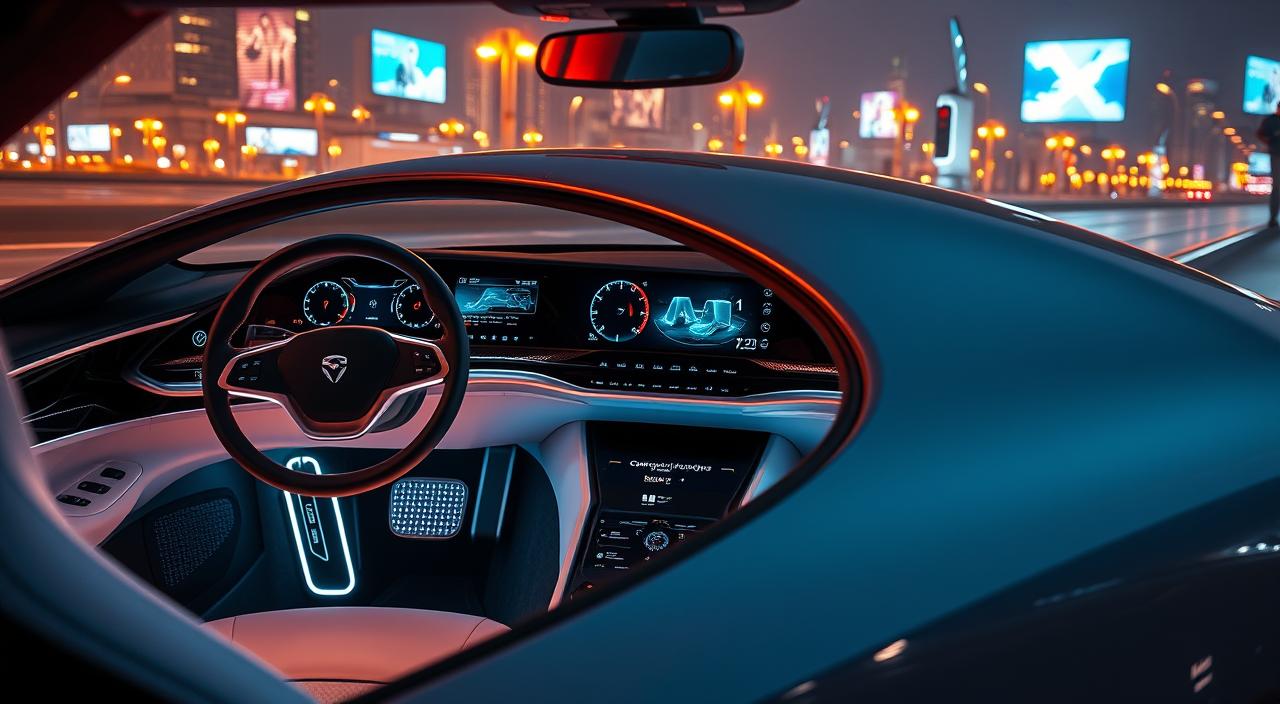
Nov
XPENG is starting mass production of flying cars by the third quarter of 2025. They plan to make 10,000 units a year. This big step in car tech will change how we travel in India and worldwide. Get ready to see amazing new car features and smart solutions.
Car tech is changing fast, with electric cars, self-driving, and green tech leading the way. These changes are making cars better and more eco-friendly. As we look at 2024’s car tech, we see new limits being pushed.
Electric cars are getting better batteries and AI systems. Self-driving cars are getting closer to being fully autonomous. AI-powered safety features will make driving safer and more comfortable.
Key Takeaways
- Flying cars are set to enter mass production by 2025, with XPENG leading the charge
- Electric vehicles are witnessing significant advancements in battery technology and AI integration
- Autonomous driving is progressing towards Level 4 and Level 5 autonomy, transforming the future of transportation
- Connectivity solutions, including 5G integration and smart infotainment systems, are enriching the in-car experience
- Eco-friendly innovations, such as sustainable materials and carbon-neutral initiatives, are driving the industry towards a greener future
Introduction to Car Tech in 2024
The year 2024 is a big step forward for car technology. The auto industry is always looking to improve safety, efficiency, and how we use our cars. Let’s explore the latest tech that’s changing how we travel.
Overview of Innovations
Car tech is getting a lot of attention, from electric cars to self-driving vehicles. Here are some key advancements:
- Next-gen battery technologies for better EV range and performance
- Level 4 and Level 5 autonomy, bringing us closer to fully self-driving cars
- Advanced driver assistance systems (ADAS) for improved safety and convenience
- Integration of 5G connectivity for seamless in-car experiences
- Eco-friendly materials and manufacturing processes for sustainable transportation
Importance of Technology in Automobiles
Technology in cars is very important. Here are some facts:
| Aspect | Impact |
|---|---|
| Safety | ADAS features have the ability to cut crashes by up to 40% |
| Efficiency | Connected car features can optimize routes, saving time and fuel |
| User Experience | Smart infotainment systems enhance in-car entertainment and productivity |
| Environmental Impact | EVs and sustainable manufacturing practices contribute to a greener future |
As car tech trends evolve, it’s clear that tech will be key in changing how we drive. From making cars safer to helping the environment, tech’s role in cars is huge.
Electric Vehicles (EVs) Advancements
The world of electric vehicles (EVs) is changing fast. New breakthroughs are pushing the industry forward. EVs are getting popular as people want to cut down on carbon emissions. Let’s explore the exciting changes in electric cars.
Next-Gen Battery Technologies
Batteries are key in electric cars, and new tech is amazing. Scientists and makers are working on better batteries. Solid-state batteries could change everything with more power and safety.
Enhanced Charging Infrastructure
More electric cars mean we need better charging spots. Governments and companies are building more charging stations. Now, fast chargers can fill up your car in no time, making long trips easier.
Integration of AI in EV Systems
Artificial intelligence (AI) is changing electric cars in big ways. AI helps manage energy, predicts when you might need repairs, and makes cars more efficient. It also makes driving safer with features like adaptive cruise control.
These changes in batteries, charging, and AI are making electric cars better. As tech gets better and more people can afford it, electric cars will be key in making our transportation greener. The future of cars is electric, and it’s looking bright.
Autonomous Driving Features
The car industry is changing fast, moving towards self-driving cars. In 2024, we’ll see big steps forward in fully autonomous vehicles. They will use advanced AI and safety systems.
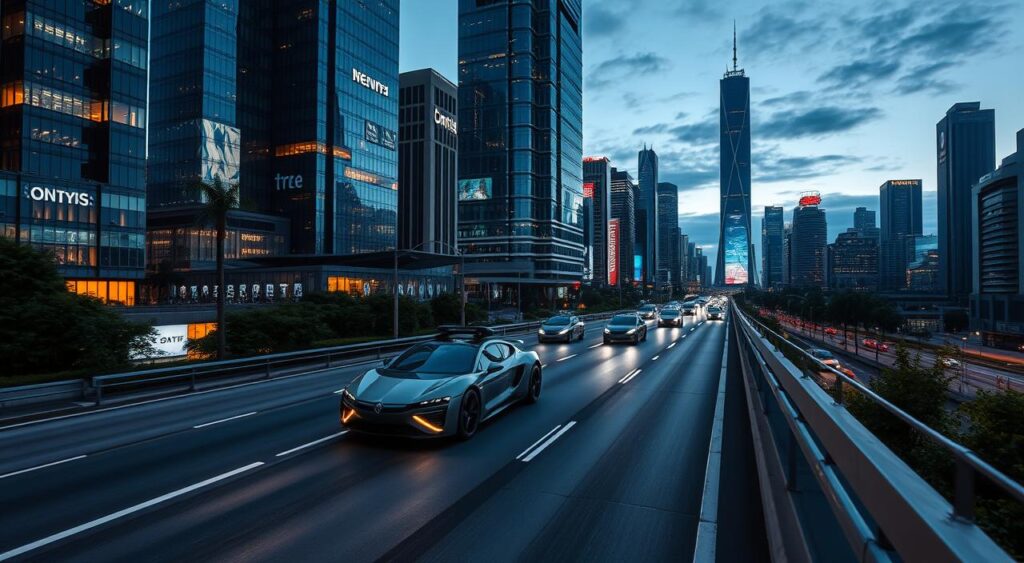
Level 4 and Level 5 Autonomy
Autonomous cars now reach Level 4 and Level 5 autonomy. This means they can drive on their own in most situations. Renesas Electronics Corporation has made new chips for cars. These chips are fast and powerful, making self-driving cars better.
Safety Enhancements through AI
AI is making self-driving cars safer. The R-Car X5H SoC from Renesas has 32 CPU cores for fast processing. It also has six CPU cores for safety, without needing extra chips. This makes cars safer and uses less power.
The market for car chips is growing fast, with a 17% CAGR from 2028 to 2031. This growth is because of the need for more safety in self-driving cars.
Regulatory Challenges Faced
Even with new tech, rules for self-driving cars are a big challenge. Governments are making laws to ensure these cars are safe on roads.
| Company | Investment | Purpose |
|---|---|---|
| Volkswagen Group | Up to $5.8 billion | Joint venture with Rivian Automotive |
| Rivian Automotive | $1 billion convertible note | Initial investment from Volkswagen Group |
Big car companies are working together to make self-driving cars. Volkswagen and Rivian are teaming up. They plan to bring self-driving cars to the market by 2027.
In-Car Connectivity Solutions
In-car connectivity is now a key focus in modern cars. Advanced technologies have made our vehicles smart, connected hubs. I’ll explore the latest solutions changing how we interact with our cars.
5G Integration for Seamlessness
5G technology has changed the game for 5G connected cars. It offers fast data transfer and low latency. This means no more buffering when downloading maps or streaming videos.
The Car Connectivity Consortium (CCC) has led this change. They’ve certified the first two digital key products as CCC Digital Key™ Certified. This milestone shows their commitment to seamless connectivity.
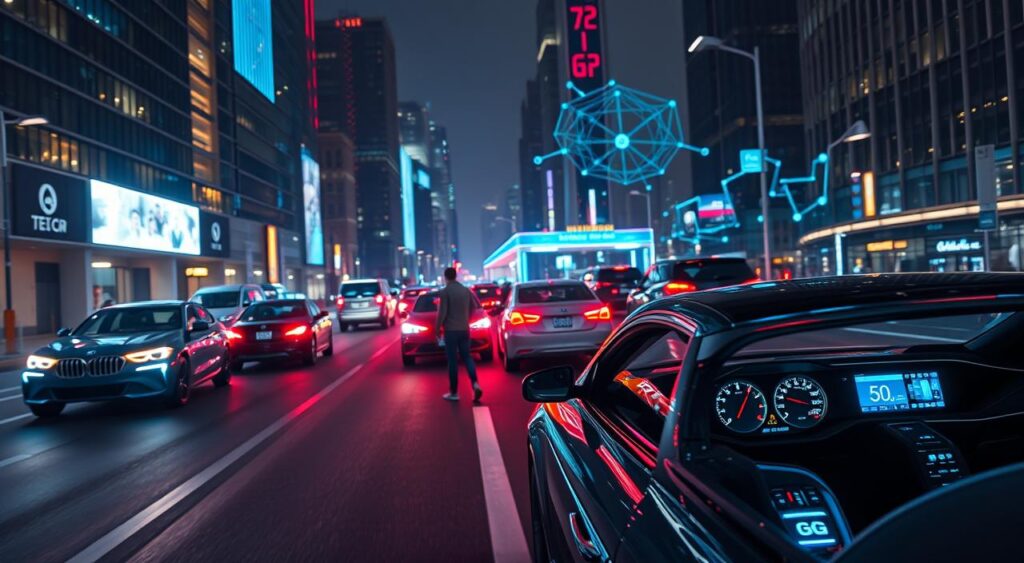
Smart Infotainment Systems
Intelligent infotainment platforms are now standard in cars. These systems provide personalized content and services. They’re easy to use, thanks to voice commands and gesture controls.
The CCC’s Digital Key™ Certification Program is growing. It will include Bluetooth Low Energy (BLE) and ultra-wideband (UWB) technologies. This will make these systems even more advanced.
Vehicle-to-Everything (V2X) Communication
V2X technology lets cars talk to their surroundings. This includes other cars, infrastructure, and pedestrians. It makes driving safer and more efficient.
Imagine your car warning you of hazards or finding the best route. It can even work with traffic lights for a smoother ride. The CCC is working to make digital keys universal. They’re promoting standards at industry events to encourage adoption.
| Technology | Benefits |
|---|---|
| 5G | Seamless connectivity, high-speed data transfer |
| Smart Infotainment | Personalized content, intuitive interaction |
| V2X | Enhanced safety, improved efficiency |
The future of seamless in-vehicle connectivity looks bright. 5G, smart infotainment, and V2X will make driving safer and more enjoyable. As the automotive industry evolves, I’m excited to see these technologies’ impact on our daily drives.
Advanced Driver Assistance Systems (ADAS)
In 2024, Advanced Driver Assistance Systems (ADAS) have made big strides. They offer better safety and convenience for drivers. These systems use AI, sensors, and advanced processing to make driving safer and more fun.
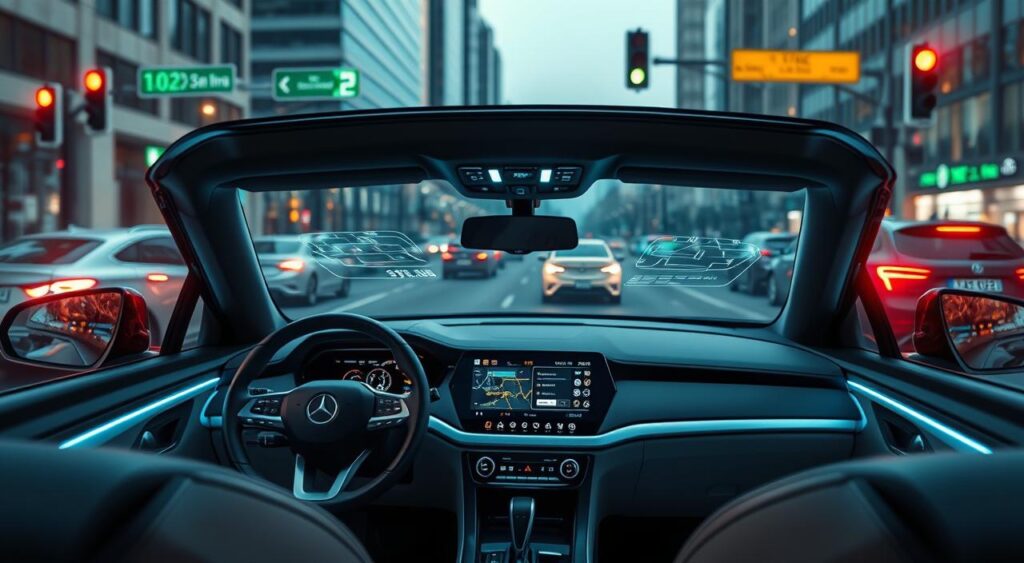
The R-Car X5H SoC by Renesas Electronics Corporation is a key advancement in ADAS. It’s built with 3-nanometer technology, providing top-notch integration and performance. This chip supports AI acceleration of up to 400 TOPS and GPU processing of up to 4 TFLOPS. It also has 32 Arm Cortex-A720AE CPU cores for app processing and six Arm Cortex-R52 CPU cores for real-time tasks.
Latest Features of ADAS in 2024
The latest ADAS features in 2024 include:
- Advanced collision avoidance systems that can detect and respond to threats in real-time
- Improved parking assist technologies, making parallel and perpendicular parking easy
- Enhanced adaptive cruise control that adjusts speed based on traffic and road conditions
- Lane keeping assist systems that keep the vehicle in its lane
These features are thanks to advancements in automotive semiconductors, like the R-Car X5H SoC. It boosts AI and graphics processing with chiplet technology. The SoC series supports AI acceleration of up to 400 TOPS and GPU processing of up to 4 TFLOPS. It also cuts power consumption by 30-35% compared to 5-nm process nodes.
Benefits for Safety and Convenience
ADAS technology brings two main benefits: enhanced safety and increased convenience. It reduces the risk of accidents by detecting and responding to hazards better than a human driver. Features like parking assist and adaptive cruise control also make driving less stressful and more enjoyable.
| ADAS Feature | Safety Benefit | Convenience Benefit |
|---|---|---|
| Collision Avoidance Systems | Reduces the risk of accidents | Provides peace of mind while driving |
| Parking Assist | Prevents collisions while parking | Makes parking effortless and stress-free |
| Adaptive Cruise Control | Maintains a safe distance from other vehicles | Reduces driver fatigue on long trips |
| Lane Keeping Assist | Prevents unintentional lane departures | Allows for a more relaxed driving experience |
As the automotive industry keeps evolving, ADAS technology will become even more important. With advancements in AI, sensors, and processing, we can expect even more sophisticated driver assistance features. This will make our roads safer and our journeys more enjoyable.
Eco-Friendly Innovations in Cars
The car industry is moving towards green technology. It’s using eco-friendly innovations to be more sustainable and reduce harm to the environment. This includes the materials used and the air inside cars.
Sustainable Materials Used in Manufacturing
Car makers are using sustainable materials in their cars. They’re using recycled plastics and bio-based composites instead of traditional materials. This cuts down the carbon footprint of making cars.
Companies like Hyundai Motor America are leading the way. They contribute $20.1 billion to the U.S. economy and support 190,000 jobs. This is through their operations and 835 independent dealers.
Innovations in Air Quality Management
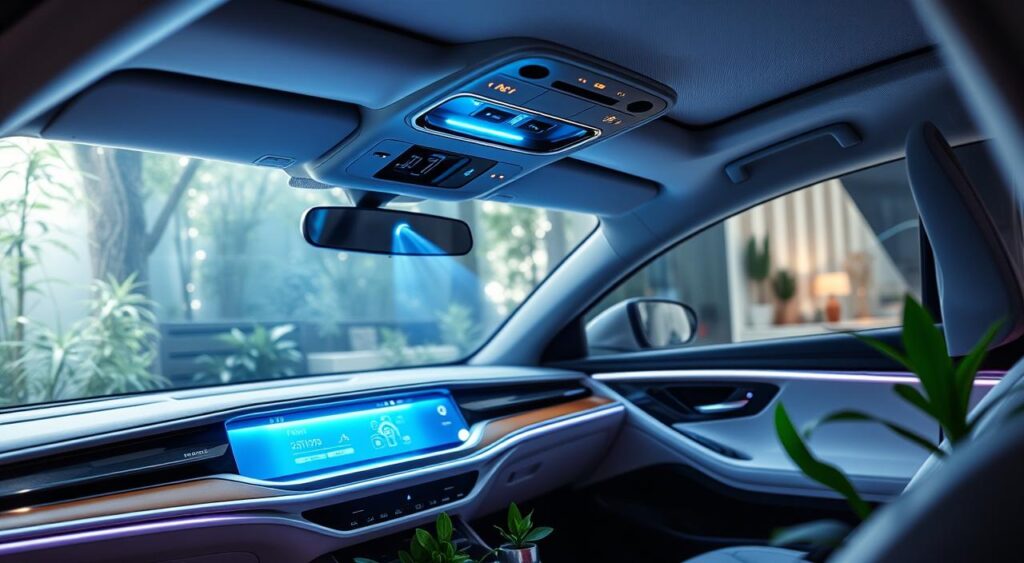
Car makers are focusing on clean air inside cars. They’re using advanced filtration systems to remove pollutants. This makes driving more pleasant.
The Hyundai IONIQ 9 is a great example. It’s an all-electric SUV that’s expected to be a hit in 2025. It has a unique design that maximizes space and efficiency.
Carbon Neutral Initiatives by Manufacturers
Car makers are also going carbon neutral. They’re using renewable energy and optimizing production. They’re investing in projects that offset carbon emissions.
This shows their commitment to sustainability. The rise of electric vehicles like the Tesla Model 3 is a big step. It can offset its pollution in just 15,000 miles.
| Car Model | Eco-Friendly Feature | Benefit |
|---|---|---|
| Hyundai IONIQ 9 | Advanced filtration system | Clean and healthy in-vehicle air |
| Tesla Model 3 | Electric powertrain | Reduced carbon emissions |
| Rivian Electric Vehicles | Remote preconditioning via app | Enhanced convenience and efficiency |
Eco-friendly innovations are key to the future of cars. They’re making cars more sustainable and clean. This includes using sustainable materials, improving air quality, and going carbon neutral.
Trends in Smart Mobility
The way we travel in cities is changing fast, thanks to smart mobility solutions. These new technologies make travel easier, more efficient, and better for the planet. Let’s dive into the latest smart mobility trends and how they’re shaping our future.
Car-Sharing and Ridesharing Technologies
Car-sharing platforms and ride-hailing apps are becoming very popular. They offer flexible and affordable travel options instead of owning a car. These services help reduce traffic and pollution by using cars more efficiently.
Impact of Mobility as a Service (MaaS)
Mobility as a Service (MaaS) combines different transport options into one easy platform. MaaS apps let you plan and book your journey all in one place. It makes traveling easier and more flexible, helping you choose the best way to get where you need to go.
| Smart Mobility Trend | Key Benefits |
|---|---|
| Car-Sharing Platforms | Reduced car ownership costs, increased vehicle utilization |
| Ride-Hailing Apps | On-demand transportation, reduced wait times |
| Mobility as a Service (MaaS) | Seamless integration of multiple transportation modes, enhanced convenience |
Trends Shaping the Future of Transportation
Looking ahead, many future transportation trends will change how we travel. Self-driving cars, for example, will make roads safer and reduce accidents. Smart traffic systems and electric vehicles will also make travel cleaner and more efficient.
These smart mobility trends are set to transform cities in India and worldwide. By embracing new technologies, we can make travel better for everyone. It’s time for us all to adapt and take advantage of these exciting changes.
Conclusion: The Future of Driving
The car industry is changing fast. Electric cars, self-driving tech, and green innovations are leading the way. These changes will make our roads safer, trips smoother, and our planet greener.
Summary of Key Innovations
The market for car voice systems is growing fast. It’s set to hit USD 8.59 billion by 2031, with a 15.2% annual growth. This is thanks to tech like speech recognition and voice biometrics in cars. Also, the armored vehicle market is expected to reach USD 32.26 billion by 2030, driven by security needs and defense spending.
My Perspective on the Evolution of Car Tech
I’m thrilled about the future of car tech. AI, 5G, and other innovations will make cars smarter and more connected. But we must be careful to keep safety and security first. Together, we can make driving better for everyone.
FAQ
What are the latest advancements in electric vehicle technology?
Electric vehicles have made big strides in 2024. New battery tech means longer drives and quicker charges. Better charging spots and AI in EVs make driving smoother and more efficient.
How has autonomous driving technology progressed in 2024?
Self-driving cars now reach Level 4 and Level 5 autonomy. This lets them drive on their own in most places. AI boosts safety, but rules need to catch up for more use.
What are the latest in-car connectivity solutions?
Cars now connect faster with 5G. Smart systems offer personalized content. V2X tech lets cars talk to their surroundings for better safety and efficiency.
How have Advanced Driver Assistance Systems (ADAS) improved in 2024?
ADAS have gotten smarter. They include features like adaptive cruise control and automatic emergency braking. These systems make driving safer and less stressful.
What are some eco-friendly innovations in cars?
Cars now use eco-friendly materials like recycled plastics. They also have better air quality systems. Companies are working to be carbon-neutral to reduce their environmental footprint.
How are smart mobility trends shaping the future of transportation?
Trends like car-sharing and MaaS platforms are changing how we travel. They offer easy and efficient ways to get around. These changes, along with self-driving cars, are shaping the future of transport.
What role does vehicle cybersecurity play in modern car technology?
With cars relying more on software, keeping them safe from hackers is key. Makers are using encryption and regular updates to protect against threats. This keeps drivers and passengers safe.
How are alternative fuel technologies contributing to sustainable transportation?
New fuel options like hydrogen and biofuels are becoming more popular. They help cut down on emissions and fossil fuel use. This makes transportation more eco-friendly for the future.
